
Mulford House, Home Sweet Home & Pantigo Mill, James Lane, East Hampton
~~~~~~~~~~~~~~~~~~~~~~~~~~~~~~
EAST HAMPTON VILLAGE
CENTENNIAL 1920 / 2020
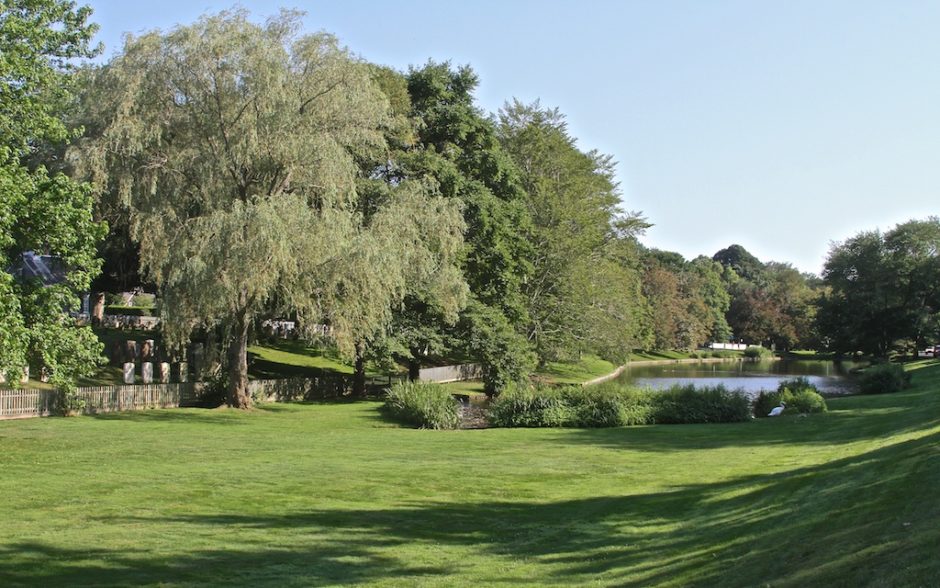
1648 VILLAGE GREEN, EAST HAMPTON
The buildings and landscapes within East Hampton’s Main Street Historic District recall important themes and periods in the history of the Village, from its founding in 1648 through two centuries as an agrarian community to its flowering as a summer resort. The Village Green recalls the very beginning of East Hampton. The settlers who arrived here from New England in 1648 laid out a broad common down the center of the fertile coastal plain beside Hook Pond. Their dwellings lined either side of the common, and on the common they built their meeting house. This compact settlement was typical of Puritan New England villages. The remnant of the 1648 common includes Town Pond, once a livestock watering hole, and the South End Burying Ground with gravestones from the 1600s.
~~~~~~~~~~~~~~~~~~~~~~~~~~~~~
~~~~~~~~~~~~~ Mulford Farm, 1680 ~~~~~~~~~~~~~
The Mulford Farm, listed on the National Register of Historic Places, is considered one of America’s most significant, intact, English Colonial farmsteads.

MULFORD FARM, James Lane: This ancient house was built around 1680 for Capt. Josiah Hobart. Samuel Mulford bought the house in 1711, and it remained in the family until 1948.
The farm is of interest not merely because of its importance to the history of East Hampton, but because of its antiquity. Viewed as an artifact that has been shaped to fit the needs and the pleasure of those who have lived in it, the house itself has much to tell us about the origins of Colonial New England society and the changes that still affect our lives today. The 1680 Mulford House represents one of the most important and complex artifacts produced by our culture — the family home.
The survival of this house, built in 1680, is remarkable since it has been left largely unchanged since 1750. The majority of the framing and wood members of the house have been left undisturbed, enabling scholars to tell the story of the successive changes over time.
In addition to the house’s architectural significance, the home has remained in the Mulford hands for the majority of its existence giving scholars the opportunity to trace the family, their use of the land and structures around them. The lives and spirit of this family echo throughout the house, which was restored using period appropriate furnishings and authentic decorative arts.
Visit: East Hampton Historical Society
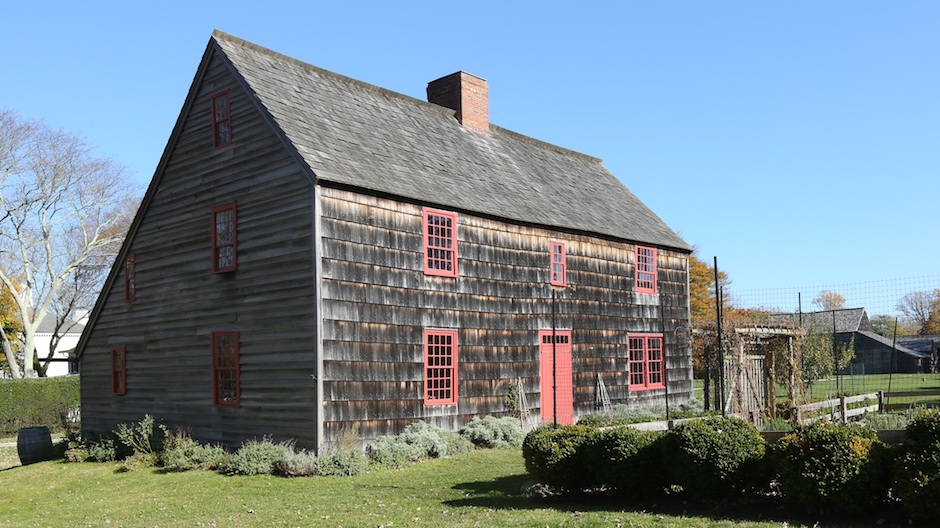
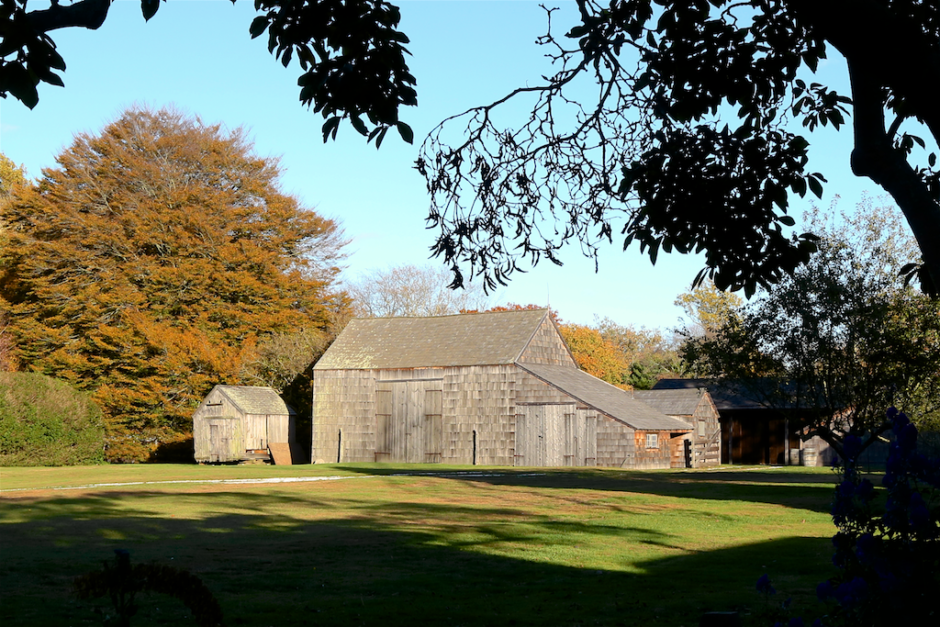
Mulford Barn.

18th century Main Street barn — reconstructed / restored, 2019 — originally at site of East Hampton Library.
————–
~~~~~~~~~~~~~ Rev. Nathanial Huntting House, 1699 ~~~~~~~~~~~~~
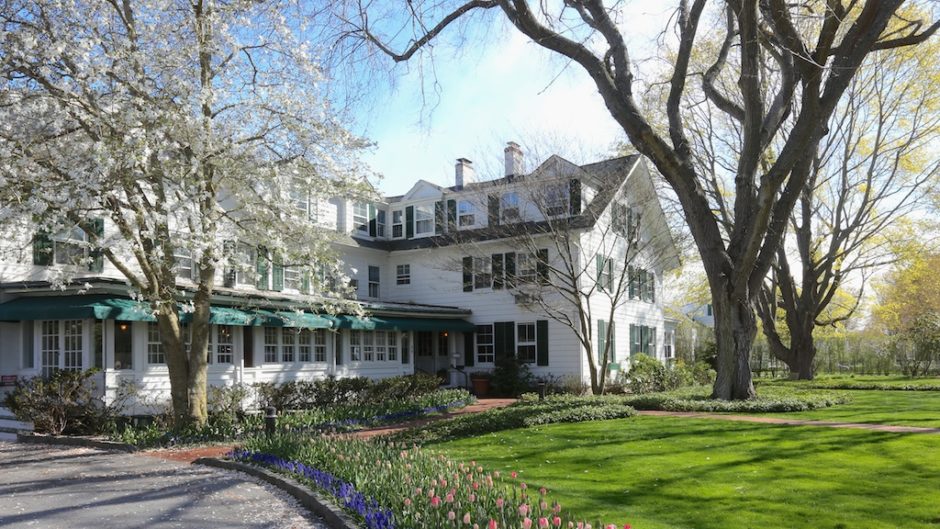
REV. NATHANIEL HUNTTING HOUSE, 94 Main Street: The original house was built for Rev. Nathaniel Huntting in 1699. Much enlarged, it has served as an inn since the American Revolution.
————–
~~~~~~~~~~~~~ Home Sweet Home, 1720 ~~~~~~~~~~~~~

HOME SWEET HOME, James Lane: This 1720 house was remodeled with Georgian interiors by Capt. Elisha Jones in 1750. John Howard Payne’s famous lyrics are forever tied to the house.
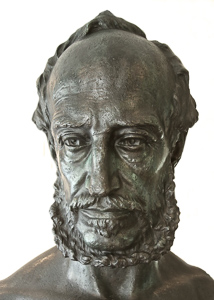
The house dates from the first quarter of the eighteenth century, with panelling installed in the parlor at mid-century. Situated on the village green in the center of colonial East Hampton, the house has come to embody the spirit of all that is tender and sweet about home.
The gardens at Home Sweet Home reflect garden styles and include plant species that were in gardens in the United States and Europe from medieval times to the nineteenth century. These include a parlor window fragrance garden, a nineteenth century pleasure garden, and an eighteenth century herb garden.
From 1907 to 1927, Mr. and Mrs. Gustav Buek owned and lived in the house and furnished every room with antique period and colonial revival pieces as well as John Howard Payne memorabilia as a shrine to one of America’s first great actors and playwrights.
Upon Mr. Buek’s death, the Village of East Hampton bought the house and the collections and opened Home Sweet Home as a museum on December 25, 1928.
———————————–
John Howard Payne’s song, Home, Sweet Home! was first sung in Covent Garden, London, in 1823, as part of his operetta (w/composer Sir Henry Rowley Bishop), “Clari, the Maid of Milan.” Since John Howard Payne had visited East Hampton as a child, and also because he had numerous relatives in East Hampton, many have attributed the inspiration for the song to the eighteenth century salt-box situated on the village green in the village of East Hampton.
Bronze Sculpture: John Howard Payne by Henry Baerer. Given by the Faust Club to the City of Brooklyn, New York, and erected in Prospect Park, September, 1873. Loaned to the Village of East Hampton by the City of New York Parks & Recreation, November, 2001.
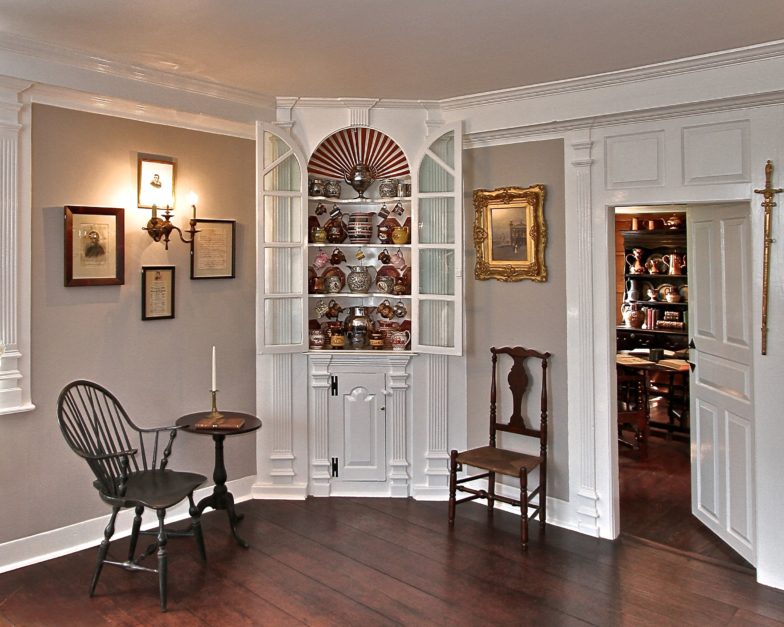
————–
~~~~~~~~~~~~~ Jonathan Osborn House, 1720 ~~~~~~~~~~~~~
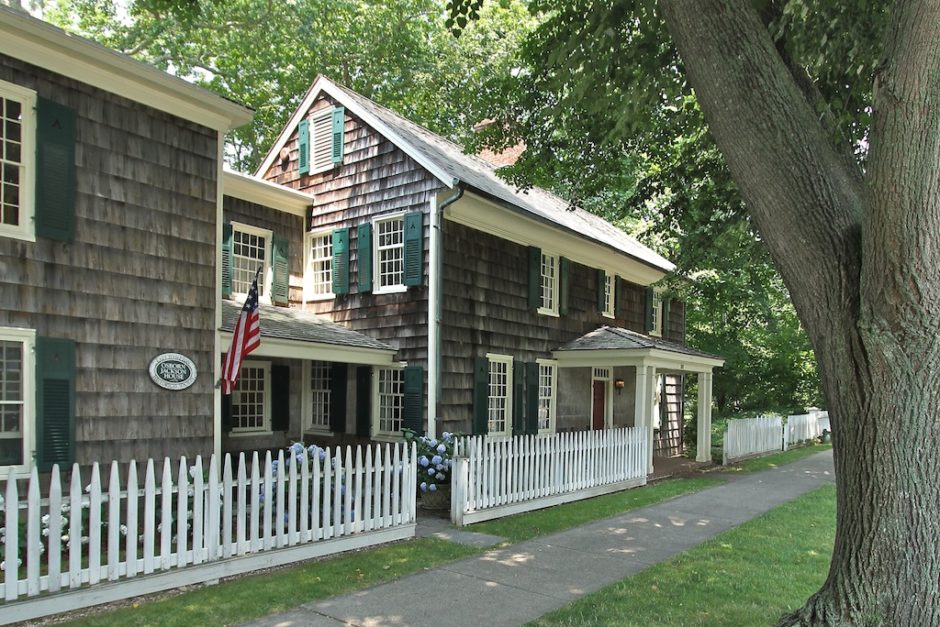
JONATHAN OSBORN HOUSE, 101 Main Street: Built as a single house (one room wide) about 1720, the Osborn house has expanded to the south, north and west. The south wing was added in the 1880s. The Osborn-Jackson House is now the headquarters of the East Hampton Historical Society.
Visit: www.easthamptonhistory.org

————–
~~~~~~~~~~~~~ Col. Abraham Gardiner House, 1747 ~~~~~~~~~~~~~
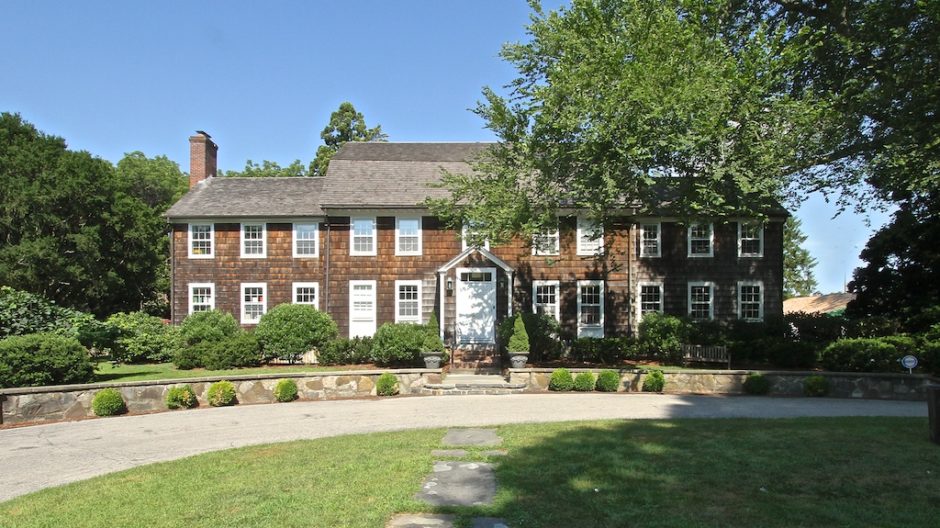
COL. ABRAHAM GARDINER HOUSE, 95 Main Street: This 1747 Georgian gambrel roof house was moved back from the street in 1924. It was occupied by British troops during the American revolution. Now headquarters of the Ladies’ Village Improvement Society, established in 1895.
Visit: www.lvis.org
Ladies’ Village Improvement Society is celebrating its 125th Anniversary / 1895 – 2020
————–
~~~~~~~~~~~~~ Jonathan Dayton House, 1770 ~~~~~~~~~~~~~
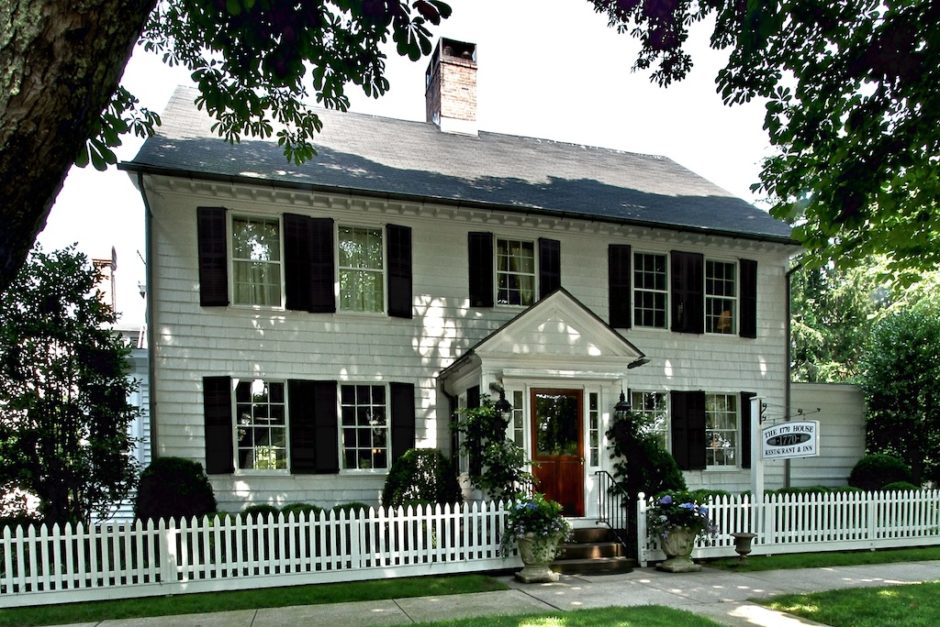
JONATHAN DAYTON HOUSE, 143 Main Street: An 18th century Georgian house with an enclosed entrance pent, the 1770 House has an elegant paneled parlor and once served as a store.
————–
~~~~~~~~~~~~~ Clinton Academy, 1784 ~~~~~~~~~~~~~

CLINTON ACADEMY, 101 Main Street: East Hampton’s Presbyterian minister, Rev. Samuel Buell, was responsible for building Clinton Academy in 1784, one of the first accredited high schools in New York State. The brick end walls, gambrel roof, belfry and front porch made this the most stylish building on Main Street at that time. Buell was influenced in his design by the buildings at his Alma Mater, Yale College. This major project, undertaken just a year following the end of the Revolutionary War, reflects the positive outlook that came with independence and a hope for what educated East Hampton youths could achieve in the new country.
Visit: www.easthamptonhistory.org
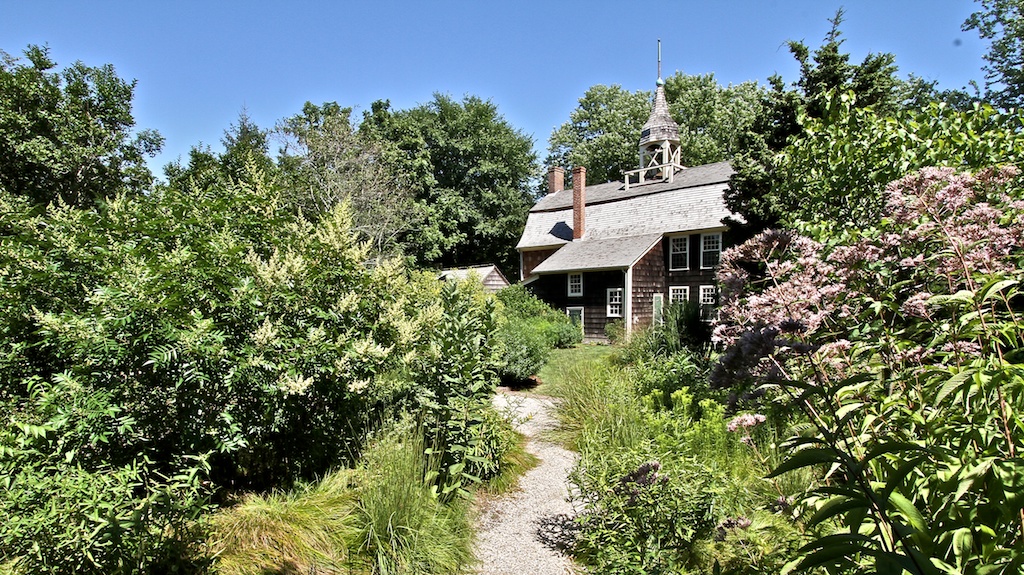
Mimi Meehan Native Plant Garden behind the Academy.
————–
~~~~~~~~~~~~~ Hook School, c. 1785 ~~~~~~~~~~~~~
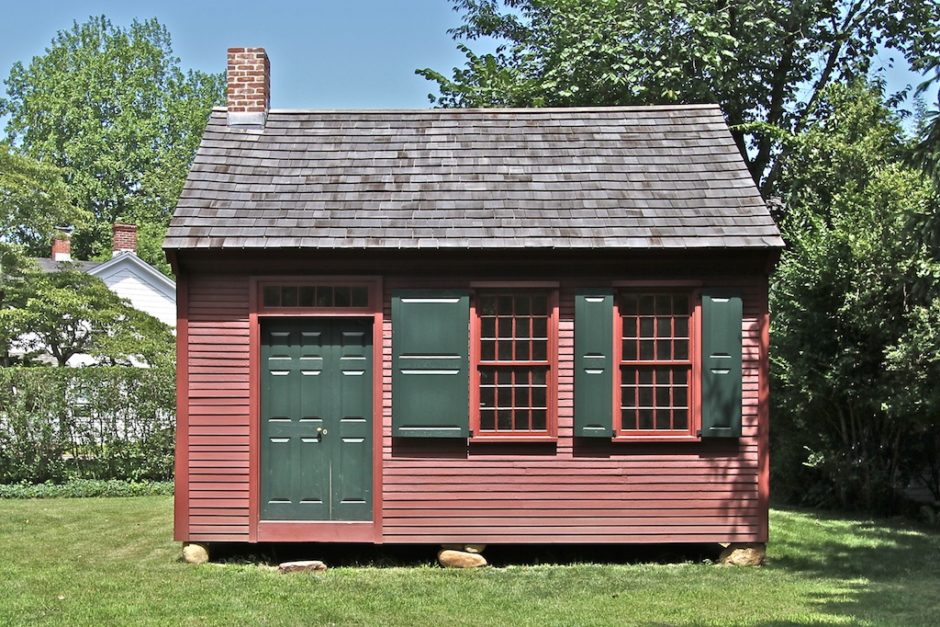
HOOK SCHOOL, next to Clinton Academy: Built around 1785, its original use is a mystery. A library or lawyer’s office, we’re not sure. It has been often and is now interpreted as a school.
Visit: www.easthamptonhistory.org
————–
~~~~~~~~~~~~~ Town House, Late 18th Century ~~~~~~~~~~~~~

TOWN HOUSE, next to Clinton Academy: The first Town House was built in the early 1730s as both a school and town hall. This late 18th century school was moved here in 1958.
Visit: www.easthamptonhistory.org
————–
~~~~~~~~~~~~~ Dominy House & Workshops, 1791 ~~~~~~~~~~~~~
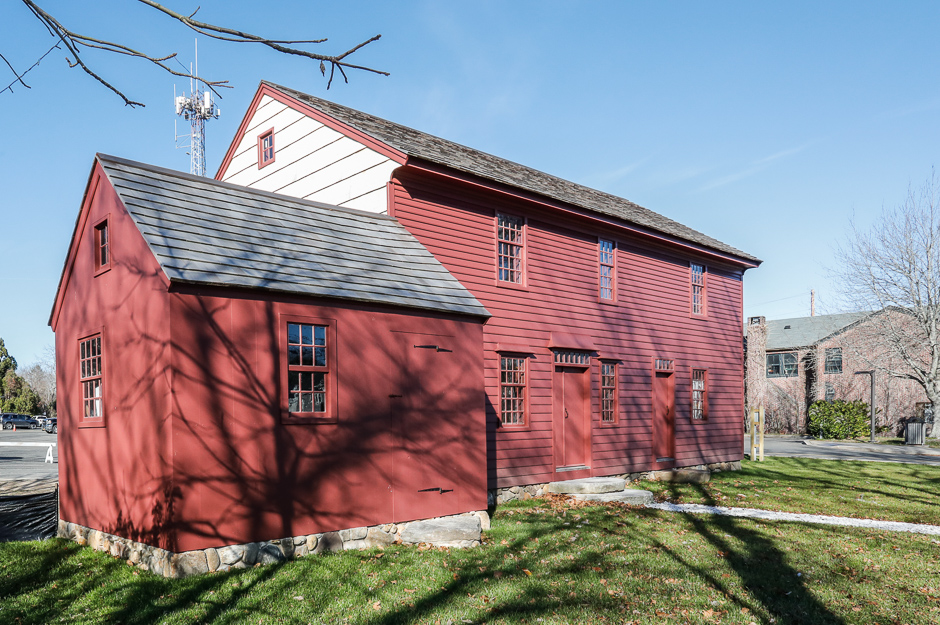
Construction / Restoration, December 3, 2020
DOMINY HOUSE & SHOPS, North Main Street: The 1791 woodworking shop and 1798 clock shop will be restored to their historic setting and context, being on their original site and being connected by an exact reconstruction of the timber frame and exterior of the Dominy House. On the interior, the reconstruction will contain an exhibit area between the two shops.
The Dominy Shops were designated a historic landmark by the East Hampton Village Board in 2013.
The Dominy Shops — Carpenter Shop + Clock Shop — were donated to the Village in 2016. These two buildings impart a tangible sense of the environment in which the Dominy craftsmen of the eighteenth and early nineteenth-century labored, particularly Nathaniel Dominy IV and Nathaniel Dominy V. Within these two shops were made many of the objects that were part of daily life in East Hampton including tall case clocks, household furniture, farm implements and windmill machinery.

AAQ / Restoration / Update: Dominy House & Shops, December 3, 2020 / Link.
————–
~~~~~~~~~~~~~ Lyman Beecher House, 1799 ~~~~~~~~~~~~~
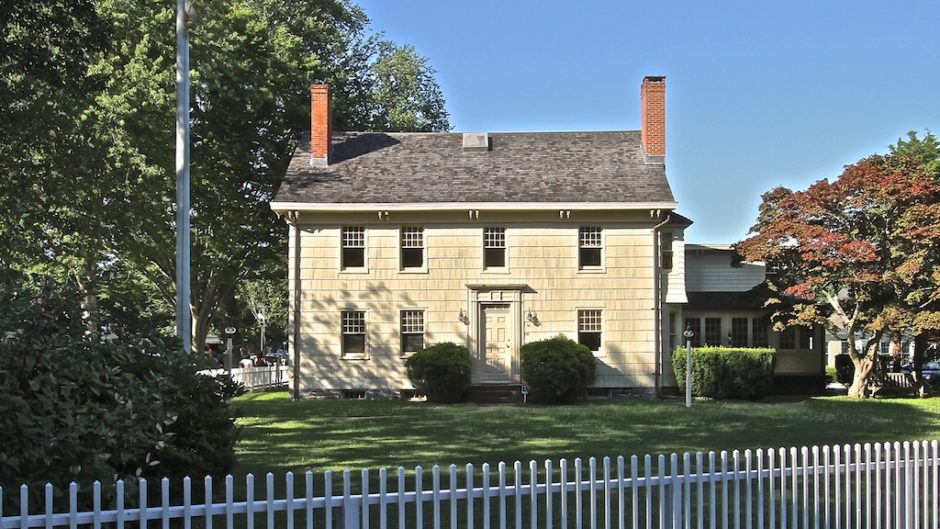
LYMAN BEECHER HOUSE, 86 Main Street: Rev. Lyman Beecher lived here from 1799 to 1810. Renovations made by George Hand in 1850 include the fine Greek Revival doorway. It is now East Hampton Village Hall.
Visit: East Hampton Village Hall
~~~~~~~~~~~~~~~~~~~~~~~~~~~~~~~~~
~~~~~~~~~~~~~ EAST HAMPTON WINDMILLS ~~~~~~~~~~~~~
For more than a century, Americans have regarded windmills as a picturesque remnant of our agrarian beginnings — a pleasant, even romantic, aspect of the landscape in certain areas of the eastern seaboard. But in their earlier life, they were hard-working laborers in the community, applying man’s ingenuity to tasks essential to survival: they ground grain, sawed wood, and pumped water.
In East Hampton Village today, Hook Mill, Pantigo Mill and Gardiner Mill still stand. They represent some of the oldest and best examples of American craftsmanship in the wooden age. These mills can be seen as testimonials of a native technology and attract us all because they are survivors of a remarkably different era. – Village of East Hampton.
~~~~~~~~~~~~~~~ Pantigo Mill, 1804 ~~~~~~~~~~~~~~~
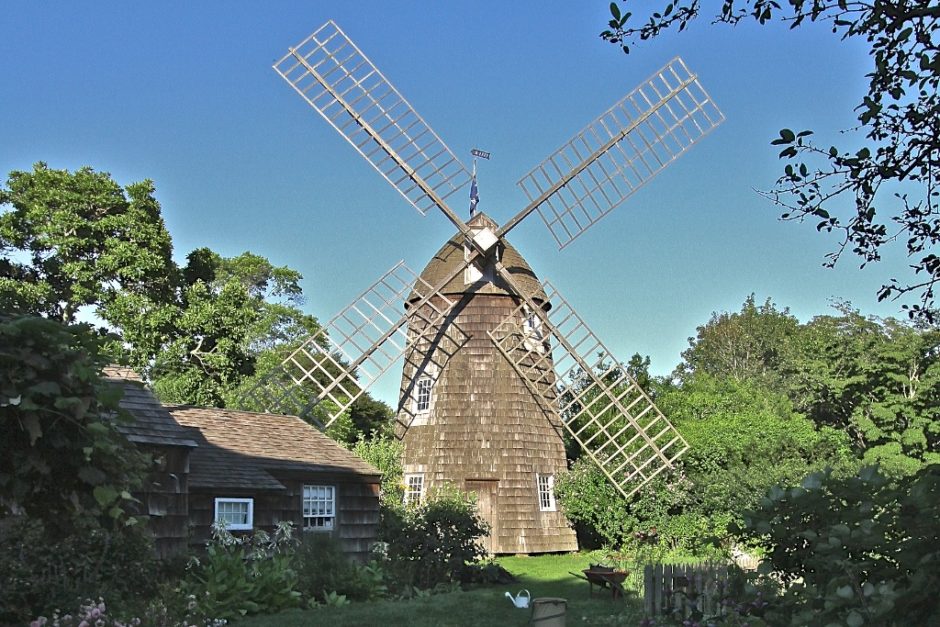
PANTIGO MILL, 1804, James Lane: Samuel Schellinger began building the Pantigo Mill for Huntting Miller in March, 1804. Ownership changed over a period of years and the mill was moved to the corner of Pantigo Road and Egypt Lane where it stood for seventy-two years when Gustav Buek purchased the mill and moved it behind Home Sweet Home. The Village of East Hampton undertook extensive repairs in 1984-1985. — Village of East Hampton
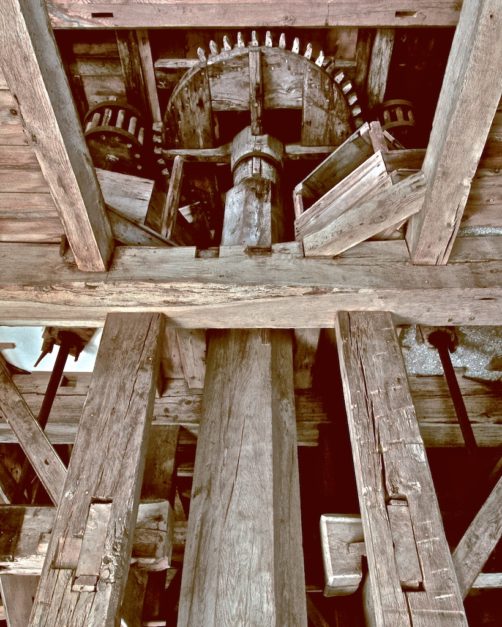
————–
~~~~~~~~~~~~~~~ Gardiner Mill, 1804 ~~~~~~~~~~~~~~~
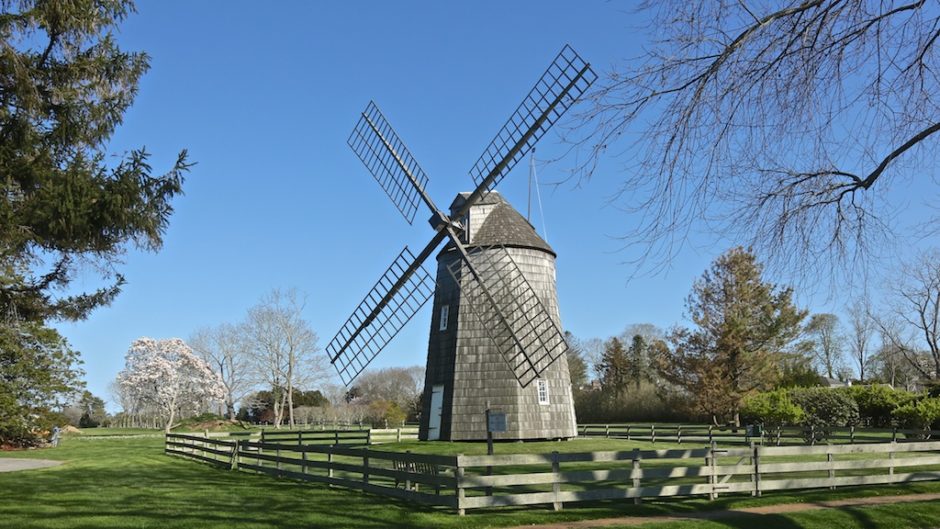
GARDINER MILL, 1804, James Lane — With a lack of streams for water power, wind power was used to grind grain. This 1804 mill, built by Nathaniel Dominy V, stands at its original location on James Lane.
A few months after Pantigo Mill was begun, a second mill was commenced on the east side of Town Pond. It was built by Nathaniel Dominy V for John Lyon Gardiner and several other sponsors. Timber for the mill was cut on Gardiner’s Island and the mill was completed on September 28, 1804, costing more than 528 pounds ($ 1,320). The mill continued to operate until 1900.
————–
~~~~~~~~~~~~~~~ Hook Mill, 1806 ~~~~~~~~~~~~~~~

HOOK MILL, 1806, 42 Main Street: The owners of a post mill on the north end of the town commissioned Nathaniel Dominy V to build a new smock mill with two pairs of millstones. The mill was built in 1806 and incorporated the main post of the 1736 mill. The Hook Mill ceased operation in 1908. The Village of East Hampton bought the mill and lot in 1922 and restored the mill to working order in 1939. It operated seasonally into the 1950s. The Village made additional repairs in 1984-85 and 2011-2012. — Village of East Hampton.
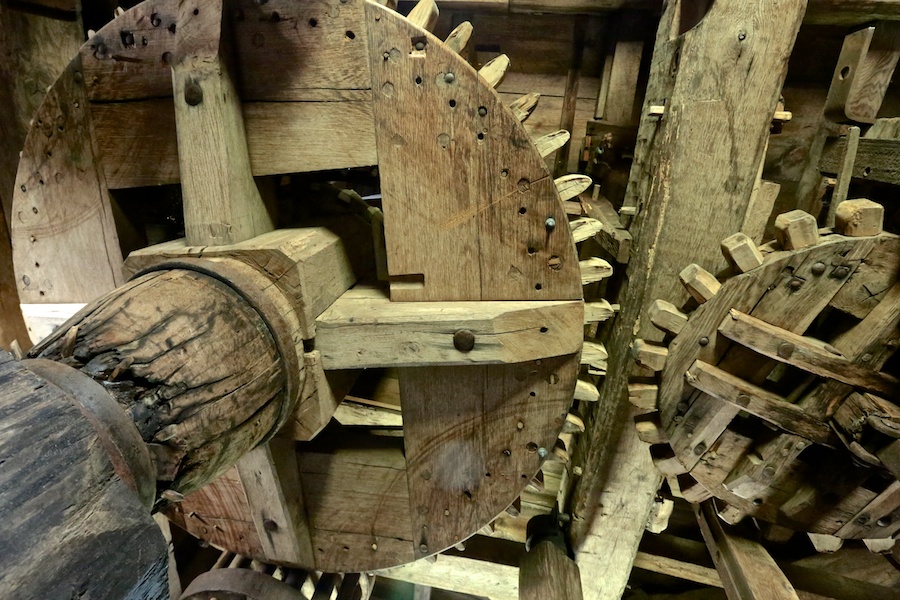
————–
~~~~~~~~~~~~~ Isaac Scoy Osborn House, 1832? ~~~~~~~~~~~~~
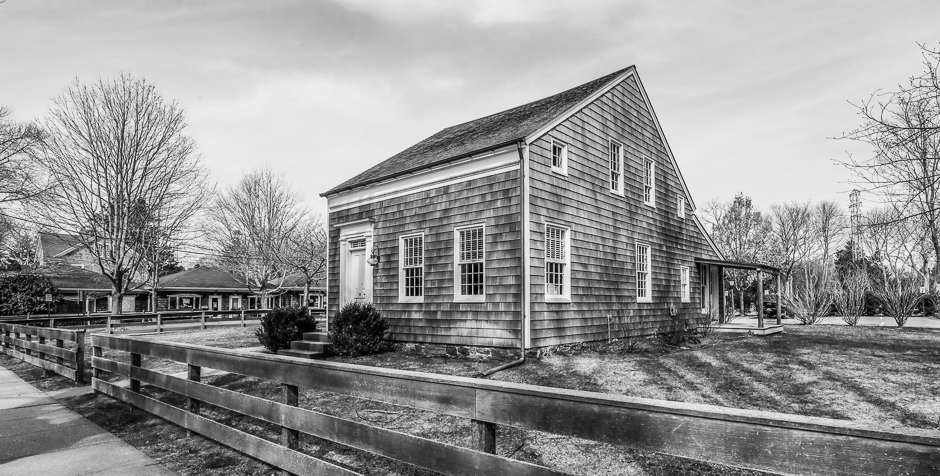
ISAAC SCOY OSBORN HOUSE, 88 Newtown Lane, built by Isaac, possibly at the time of his marriage to Cahterine Glover, 1832. The house stood on the ten-acre Osborn home lot, part of the “New Town” lots laid out in the 1660s to accommodate expansion of the Main Street settlement.
The Isaac Scoy Osborn House and Outbuilding possess special character, aesthetic and historic interest and value as part of the cultural, economic and social history of East Hampton; embody the distinguishing characteristics of an architectural style; and represent an established and familiar visual feature of Newtown Lane.

The design of the new front door enframement was based upon historic photographs, the sample of a smilar doorway by the same builder and by the principles prescribed in Asher Benjamin’s pattern books of the 1830s and 1840s.
————–
~~~~~~~~~~~~~ William L.H. Osborn House, 1840 ~~~~~~~~~~~~~
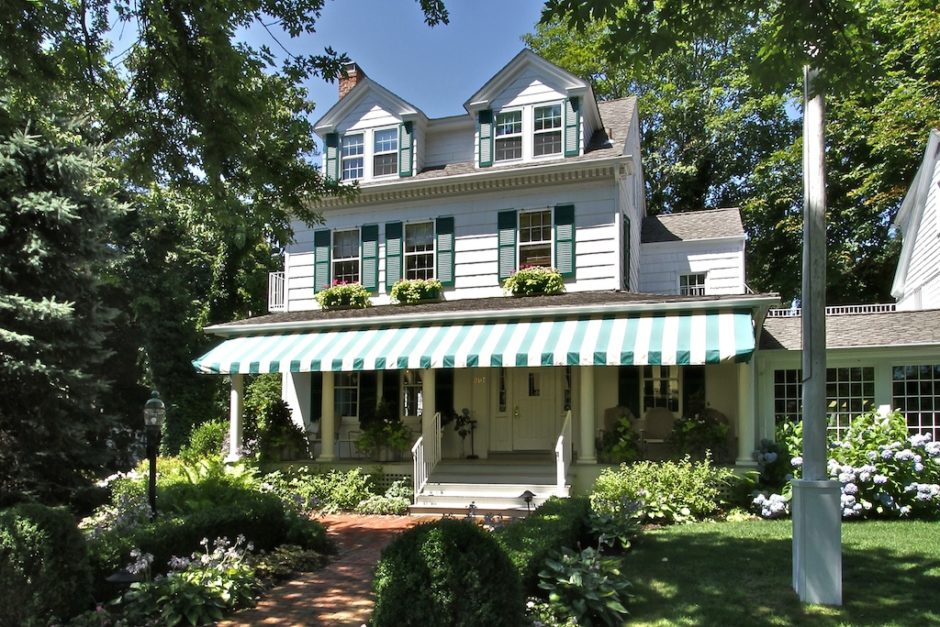
WILLIAM L.H. OSBORN HOUSE, 207 Main Street: Built in 1840 as an inn, it now welcomes guests c/o The Maidstone. The front doorway is the finest Greek Revival example in the village.
————–
~~~~~~~~~~~~~ First Presbyterian Church ~~~~~~~~~~~~~

FIRST PRESBYTERIAN CHURCH OF EAST HAMPTON, 120 Main Street: An 1861 Romanesque revival church was remodeled in the Colonial Revival mode in 1960 with the addition of the portico, bell tower and spire.
————–
~~~~~~~~~~~~~ Gardiner Mill Cottage, 1870 ~~~~~~~~~~~~~

MILL COTTAGE, James Lane: An ancient timber-frame structure on the Gardiner Home Lot was made into this dwelling in 1870 for the miller tending the Gardiner Windmill.

Gardiner Mill Cottage Gallery / 2019
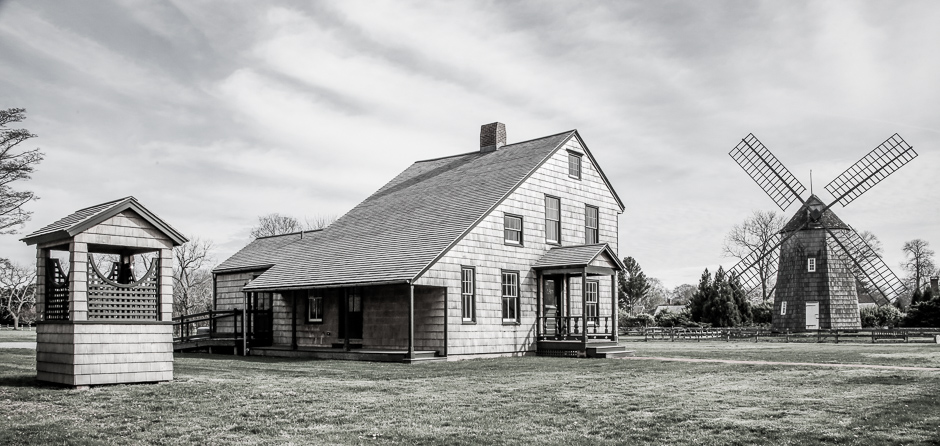
Gardiner Mill Cottage & the Gardiner Mill.
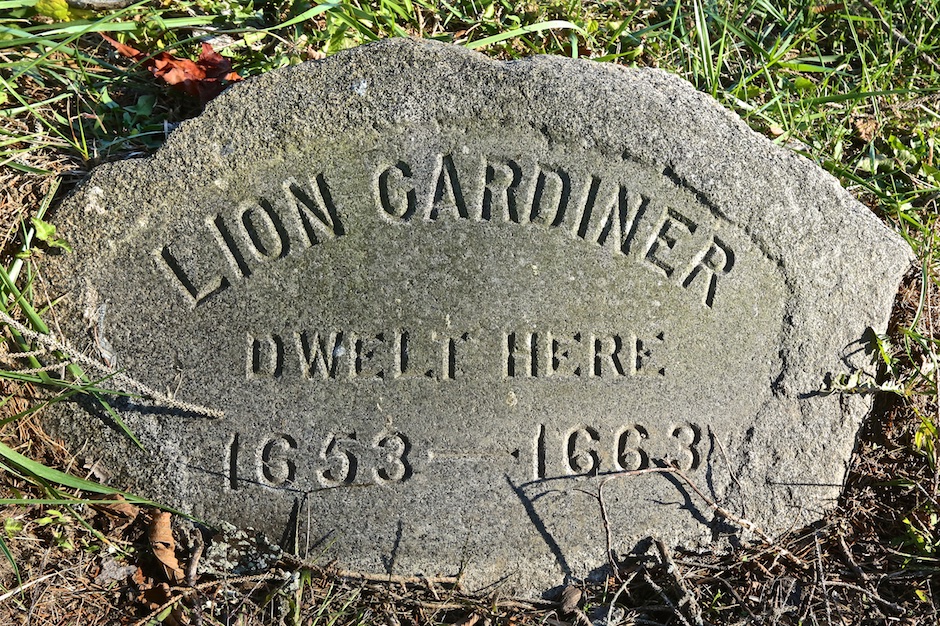
————–
~~~~~~~~~~~~~ Hedges Inn, 1873 ~~~~~~~~~~~~~
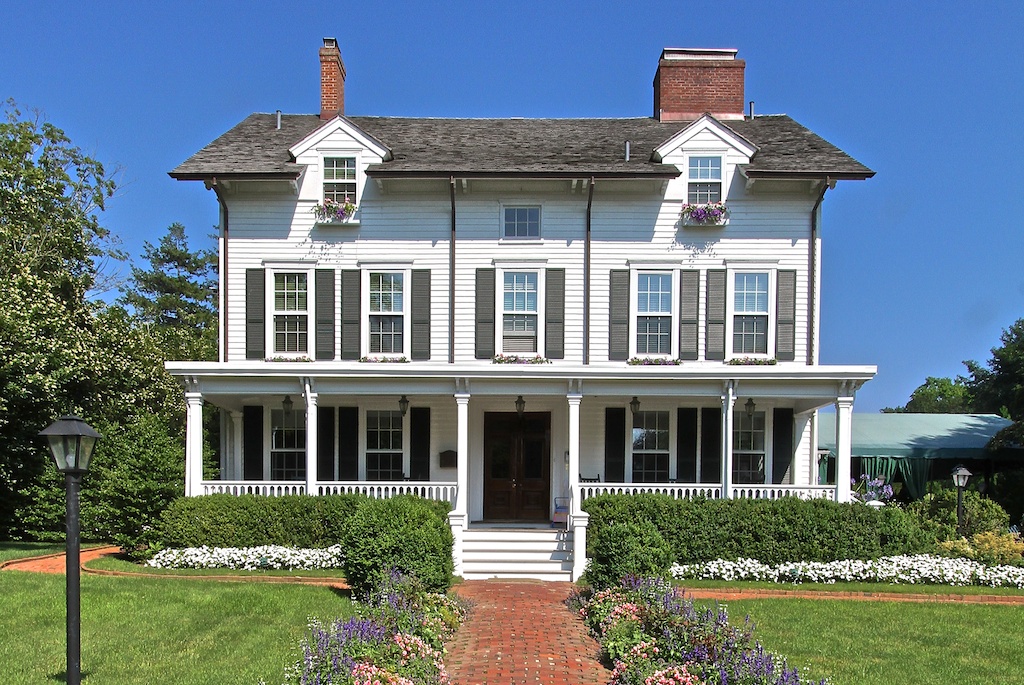
HEDGES INN, 74 James Lane: Summer Boarding Houses: By the 1840s East Hampton began to be discovered as a summer resort. With the extension of the Long Island Railroad to Bridgehampton in 1870, East Hampton’s beaches, cool sea breezes and quiet, rural environment became more easily accessible to residents of New York City. Summer visitors stayed in boarding houses on Main Street. The Hedges Inn, built in 1873 by John D. Hedges, featured a broad veranda, a double front doorway, a commodious dining room across the back of the house, a large kitchen wing and rooms for boarders on the upper floors. Two other early boarding houses, The Huntting Inn and The Osborn House (now c/o The Maidstone), remain open today providing visitors with an experience of historic East Hampton.
————–
~~~~~~~~~~~~~~~~~~~~ Moran Studio, 1884 ~~~~~~~~~~~~~~~~~~~~

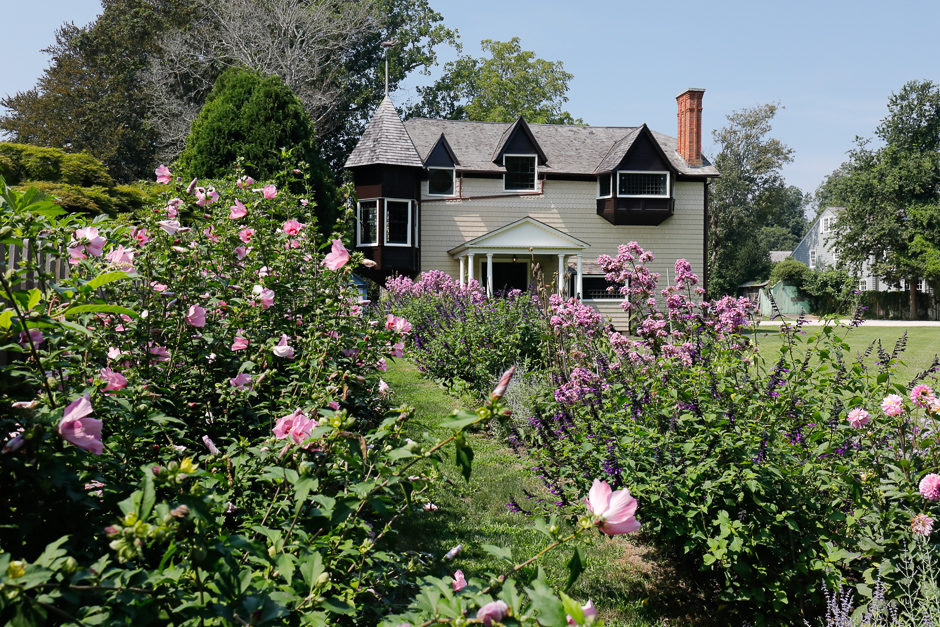
MORAN STUDIO, 1884, 229 Main Street: The determining feature of Thomas Moran’s design is the one large 24’ x 40’ two-story space which was entered directly through the front door and which was intended to be an art studio first and living space second. Bedrooms were on the third floor. The service wing for food preparation and domestic chores was a minimal attachment, if it existed at all in 1884.
Thomas Moran’s idea of a single studio space for multiple activities with a suite of bedrooms for the family perched on top determined much of the character of The Studio: its essential simplicity, its modest scale, and its informality. It was a simple concept that allowed Thomas Moran to be the designer and to easily collaborate with Stafford Tillinghast (the builder) in determining the mechanics of construction.
Thomas Moran was clearly influenced by the English Queen Anne style in giving The Studio an appropriately artistic exterior. Queen Anne features include: the overall asymmetrical composition of the front façade; the many different types of windows; the Queen Anne window sash with large panes of glass surrounded by a border of small panes; the projecting oriel window and bay window on the front façade; the corner turret with its steep cap; the dormers with steep gables; the clipped gables; and the paneled chimney stack. While most Queen Anne houses have a complex plan, Stafford Tillinghast built a simple barn-like structure that Thomas Moran decorated with asymmetrically-placed features typical of the Queen Anne style.
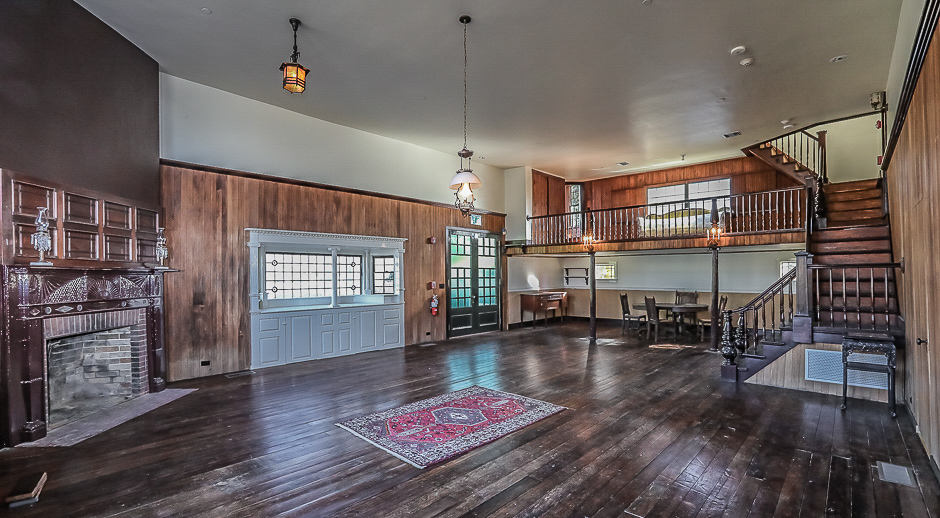

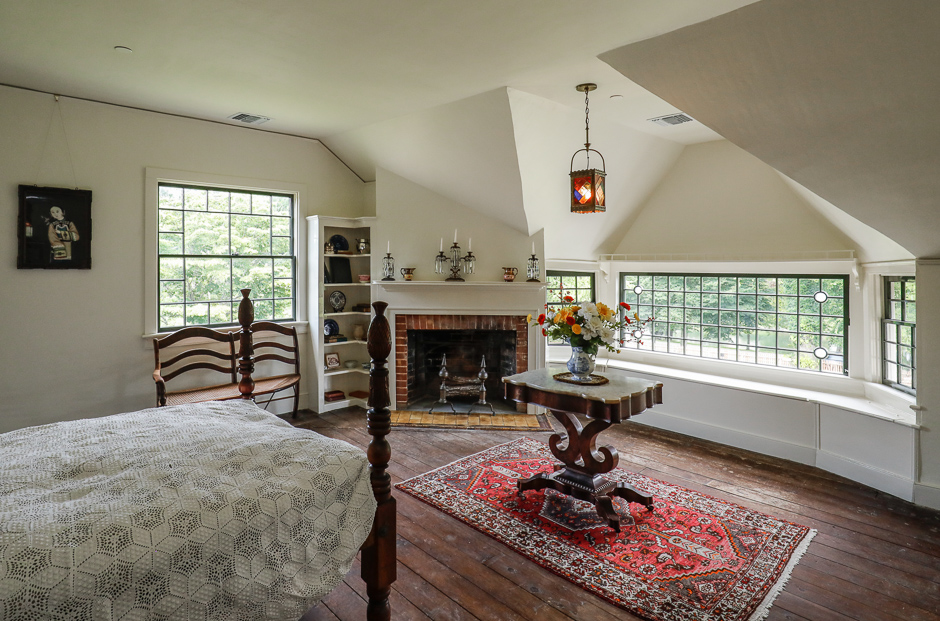
Master Bedroom

Victorian Christmas 2020
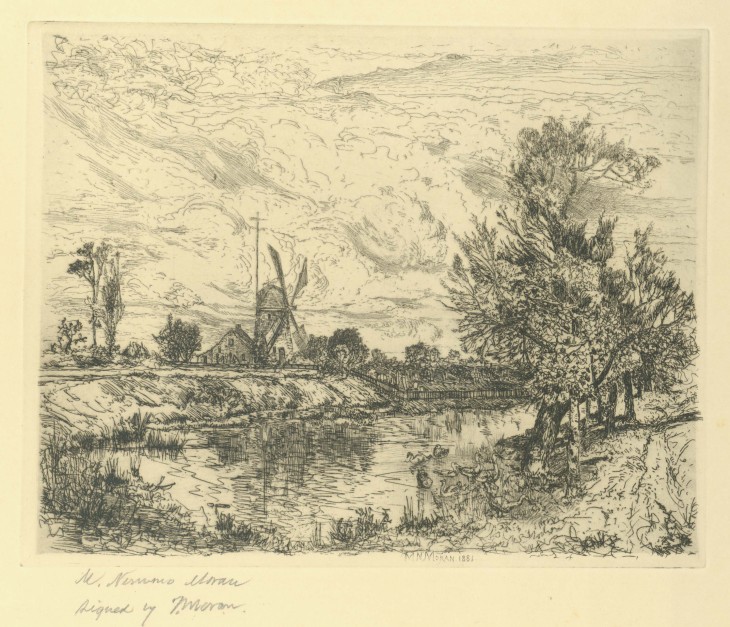
The Goose Pond (Town Pond), etching by Mary Nimmo Moran, 1881, signed by Thomas Moran. Courtesy of the East Hampton Library.
————–
~~~~~~~~~~~~~ Tomb of Lion Gardiner, 1886 ~~~~~~~~~~~~~
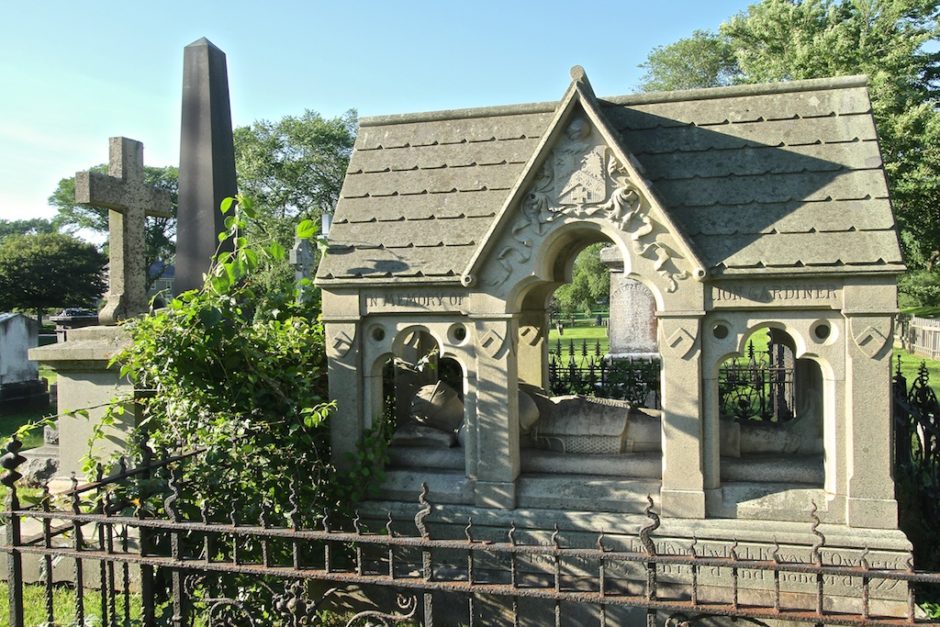
IN MEMORY OF LION GARDINER, 1599-1663, South End Cemetery. Tomb, built in 1886, was designed by James Renwick, Jr., noted architect of St. Patrick’s Cathedral.

South End Burying Ground
————–
~~~~~~~~~~~~~ St. Philomena’s Church, 1894 ~~~~~~~~~~~~~
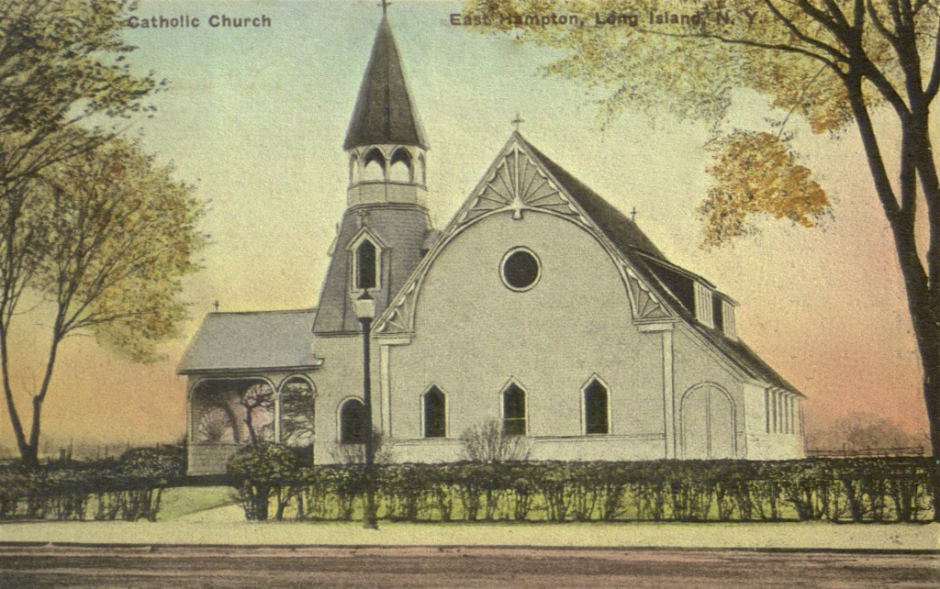
St. Philomena’s Church, 1894; 1897; 1938 alterations (steeple). Architect identified, at the time, as ‘Aldrich, brother of John Aldrich’.
————–
~~~~~~~~~~~~~ East Hampton Village Train Station, 1898 ~~~~~~~~~~~~~
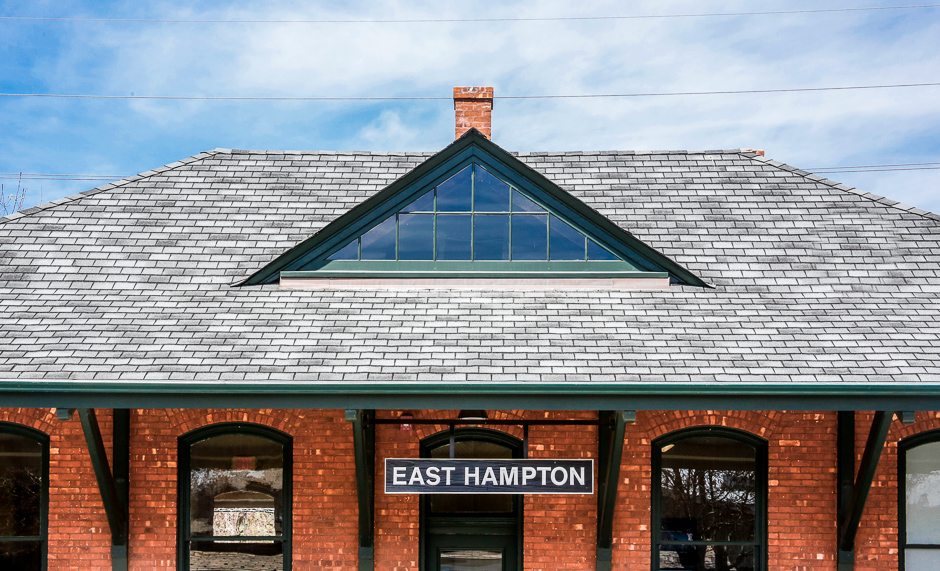
EAST HAMPTON VILLAGE TRAIN STATION, 1895.
PLAQUE: “The Cannonball & Hamptons Reserve — Train service to East Hampton started on June 1, 1898, when through service to Amagansett began. The original station building, which opened in the summer of 1895, is still standing and is one of the few stations that has retained its original appearance both inside and outside.”
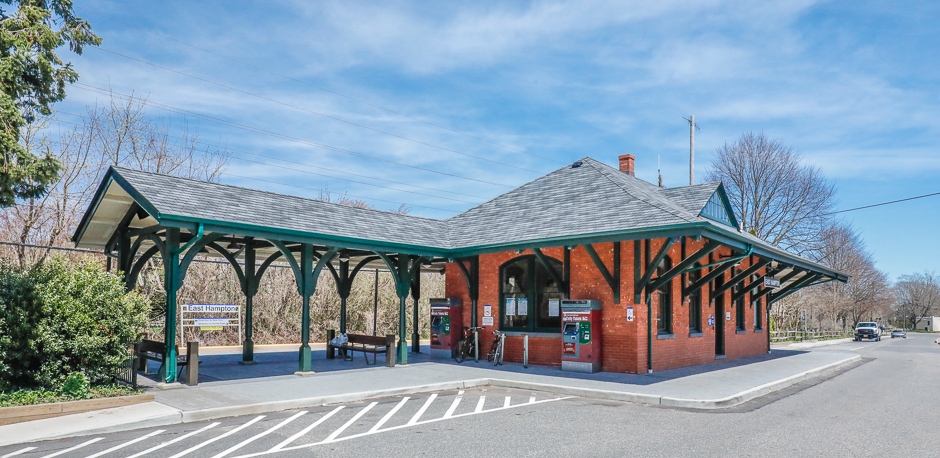

Archival Postcard / Ginsburg Postcard Collection. Courtesy of East Hampton Library.
————–
~~~~~~~~~~~~~ ODD FELLOWS HALL, 1897 ~~~~~~~~~~~~~

ODD FELLOWS HALL, 1897, 26 Newtown Lane. The Hampton Lodge of the Odd Fellows, founded in 1890, had eighty-five members by the time this building was constructed. Designed in the Shingle Style by J.G. Thorp, the Hall was originally painted a dark green. Steel trusses provide support for the open second floor.
————–
~~~~~~~~~~~~~ Town Pond, ca. 1900 ~~~~~~~~~~~~~
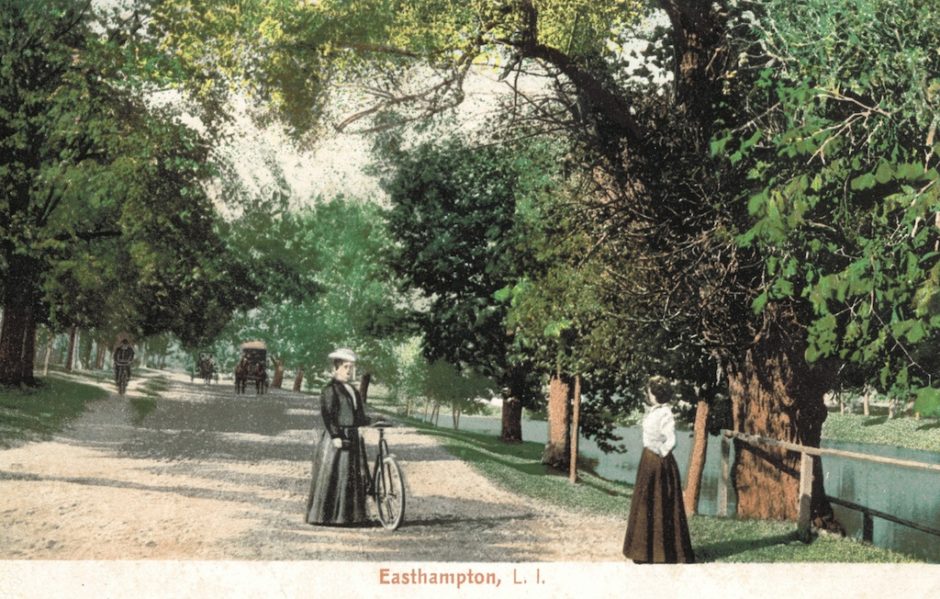
TOWN POND POSTCARD, ca. 1900: Main Street: south end of Town Pond. Courtesy of the East Hampton Historical Society.
Archival Postcard / Ginsburg Postcard Collection. Courtesy of East Hampton Library.
————–
~~~~~~~~~~~~~~~~~~~~ Bathing Pavilion Main Beach, 1900 / 1901 ~~~~~~~~~~~~~~~~~~~~
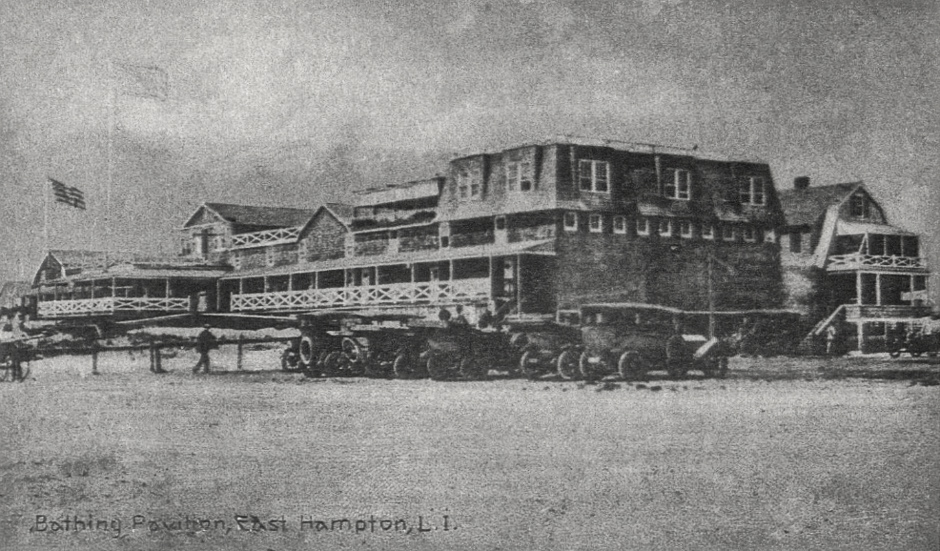
BATHING PAVILION MAIN BEACH, 1900 / 1901: Austin H. Culver had plans drawn in 1900 for the reconstruction of the older Maidstone bathhouses, built probably in the 1870s, into a new bathing pavilion. The plans called for moving and connecting them into one large structure with a piazza across the front, a “sun bath” at the rear, and a bathroom for “warm sea baths on the second floor.
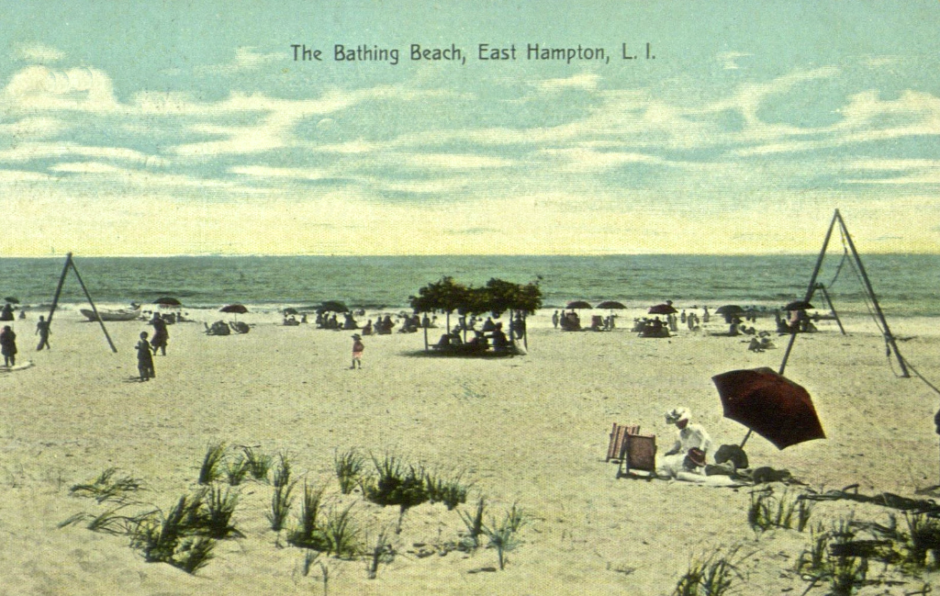
Archival Postcard / Ginsburg Postcard Collection. Courtesy of East Hampton Library.
————–
~~~~~~~~~~~~~ United Methodist Church of East Hampton, 1901 ~~~~~~~~~~~~~
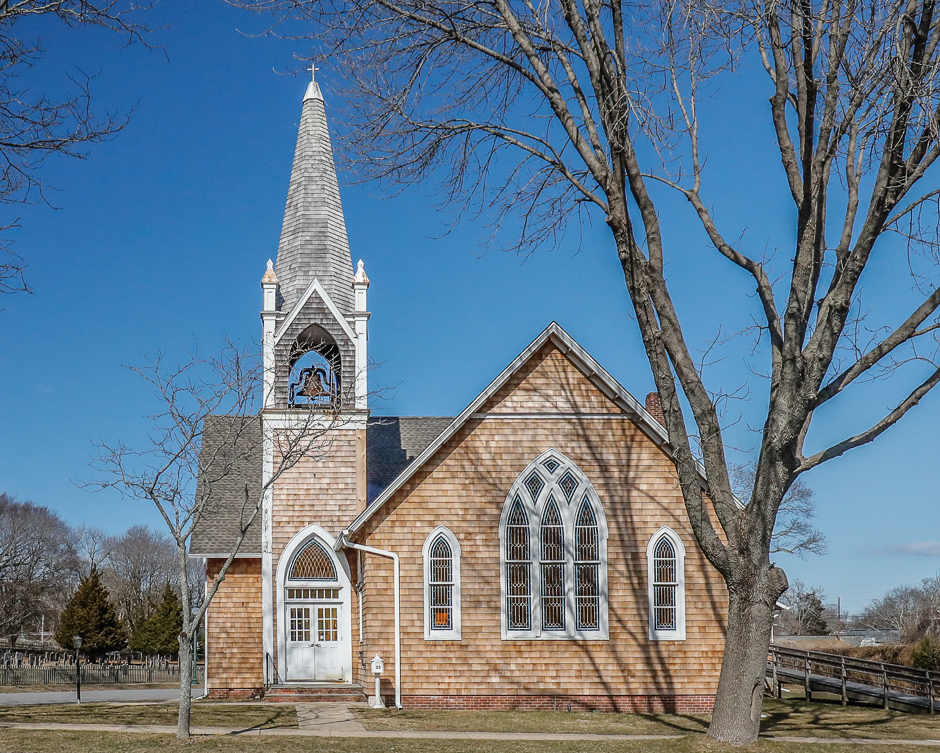
UNITED METHODIST CHURCH OF EAST HAMPTON, 1901, 35 Pantigo Road. A.O. Jones, Builder. The Methodist congregation brought a resident pastor to East Hampton in 1894 and renovated the old North End school house, known as the Eelpot, for their first church. This new church was built on the same site in 1901. The Eelpot was moved to the back of the lot and in 1960 was moved again to Amagansett.
————–
~~~~~~~~~~~~~ Edwards Drug Store, 1901 ~~~~~~~~~~~~~
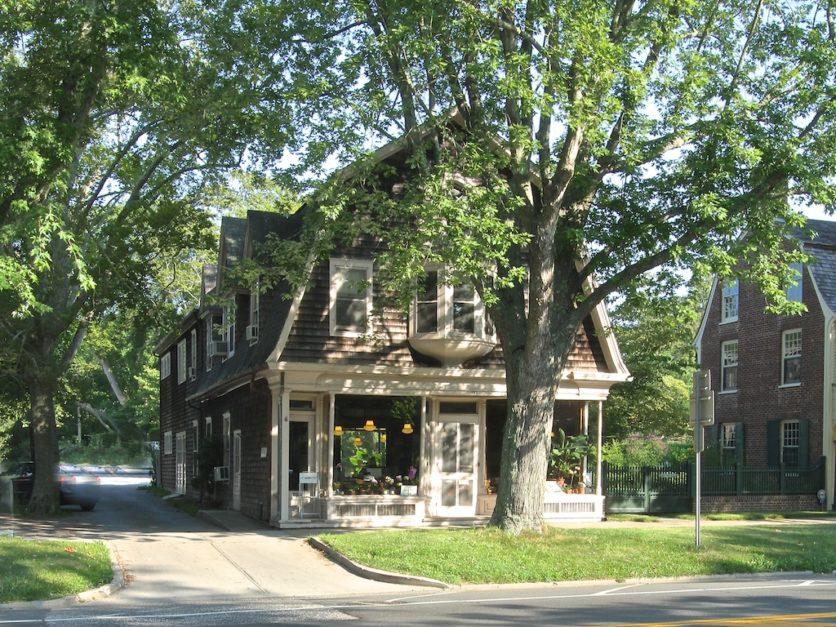
EDWARDS DRUG STORE, 1901, 153 Main Street: Everett Edwards had this structure built in 1901 to house his pharmacy. A contemporary newspaper account noted that “the exterior of the store…will…more nearly resemble a colonial cottage than a business building.” The interior furnishings designed by J.C. Lawrence included a ceiling of “opal glass of a green shade, laid in panels,” and a white mosaic tile floor. In 1940, Arnold Rattray, publisher of the East Hampton Star, moved the newspaper’s office to this site.
————–
~~~~~~~~~~~~~ George Hand Building, 1904 ~~~~~~~~~~~~~
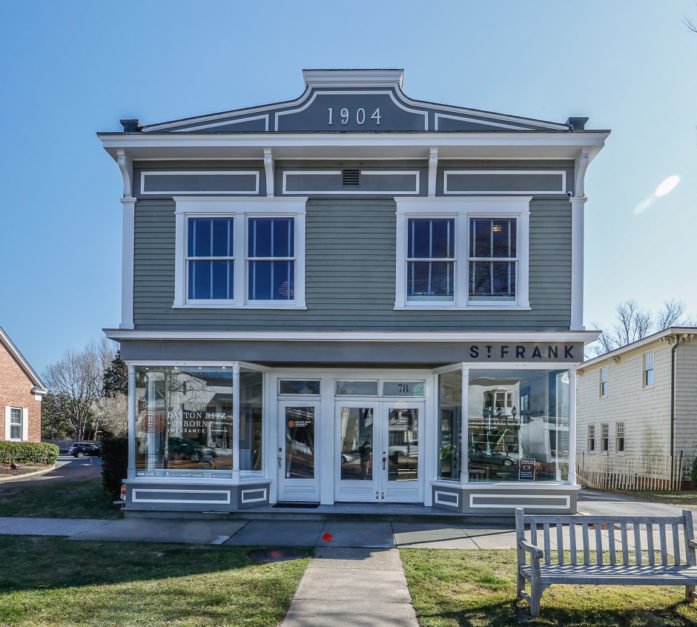
GEORGE HAND BUILDING, 78 Main Street. John Curtis Lawrence, architect.
————–
~~~~~~~~~~~~~~~~~~~~ Business Section ~~~~~~~~~~~~~~~~~~~~
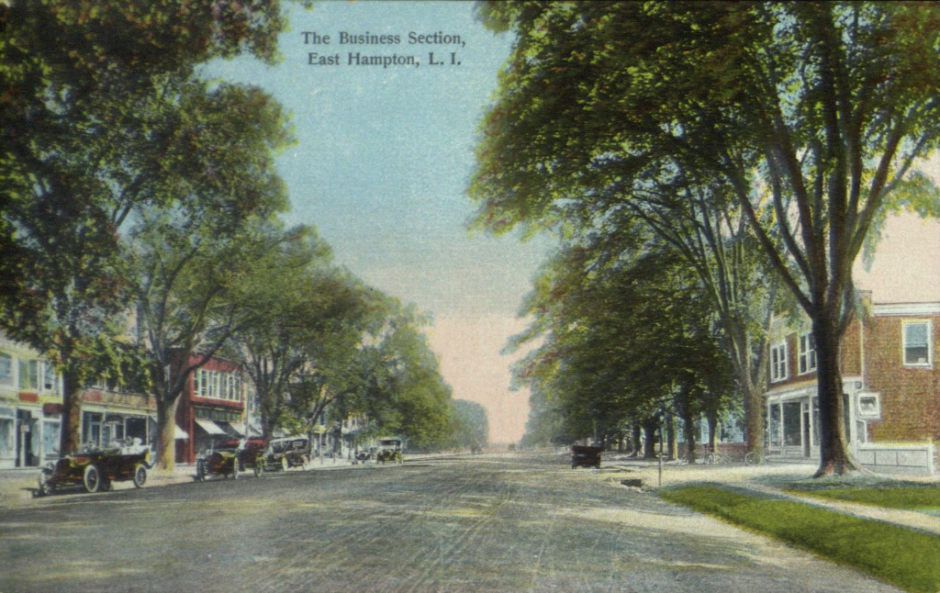
Archival Postcard / Ginsburg Postcard Collection. Courtesy of East Hampton Library.
————–
~~~~~~~~~~~~~~~~~~~~ G.A. Howard Building, 1907 ~~~~~~~~~~~~~~~~~~~~
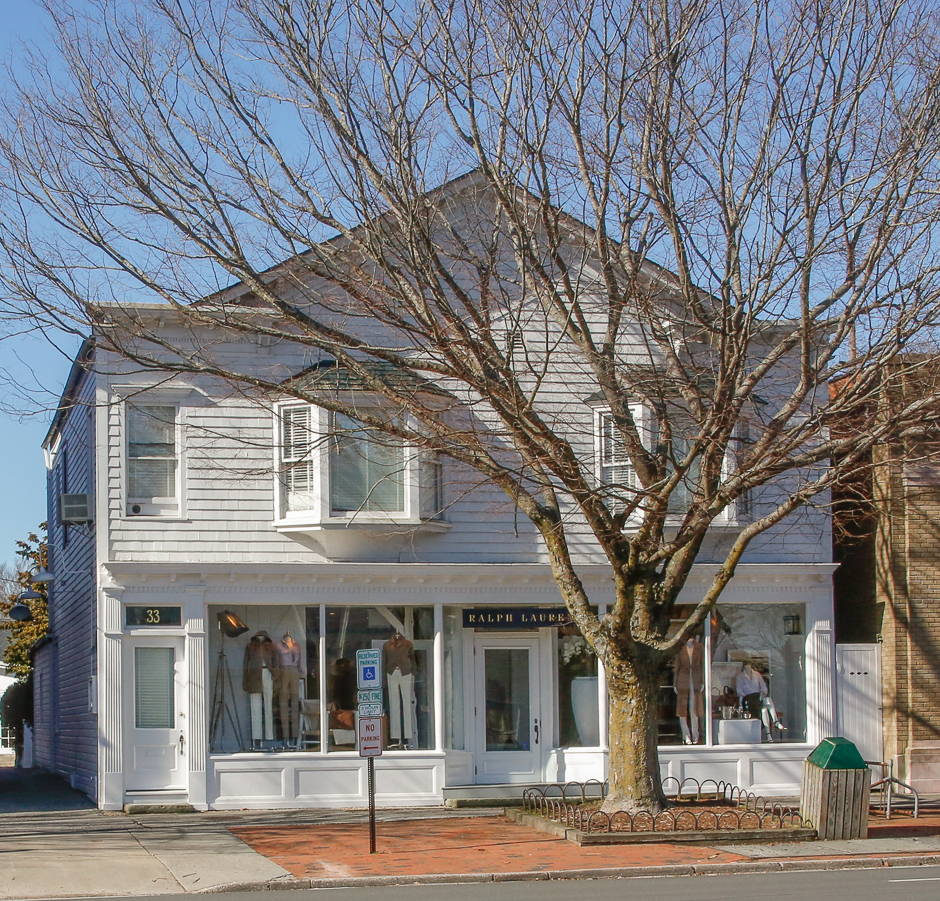
G.A. HOWARD BUILDING, 1907, 31-33 Main Street.
————–
~~~~~~~~~~~~~ St. Luke’s Episcopal Church, 1909/10 ~~~~~~~~~~~~~
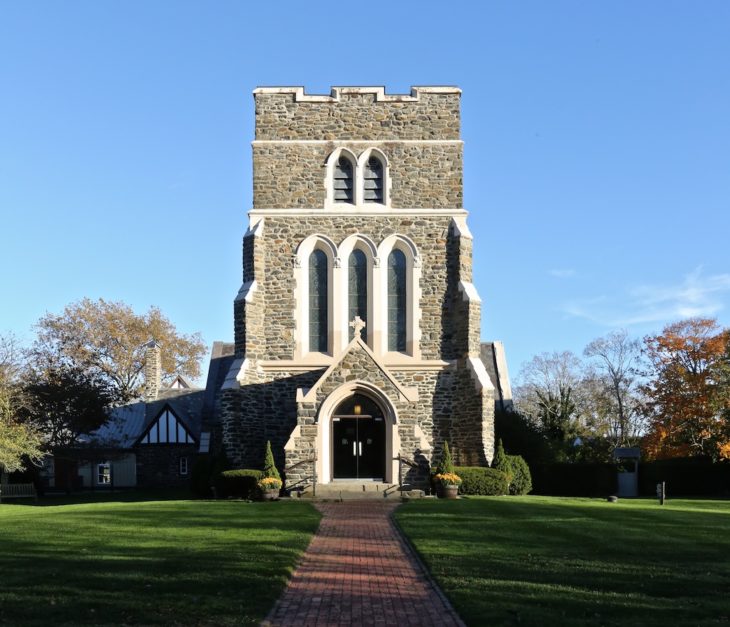
ST. LUKE’S EPISCOPAL CHURCH, 18 James Lane: Thomas Nash, architect of this 1909 church, modeled it after All Saints Church in Maidstone, England.
Visit: St. Luke’s Episcopal Church
————–
~~~~~~~~~~~~~ East Hampton Free Library, 1910 / 1911 ~~~~~~~~~~~~~
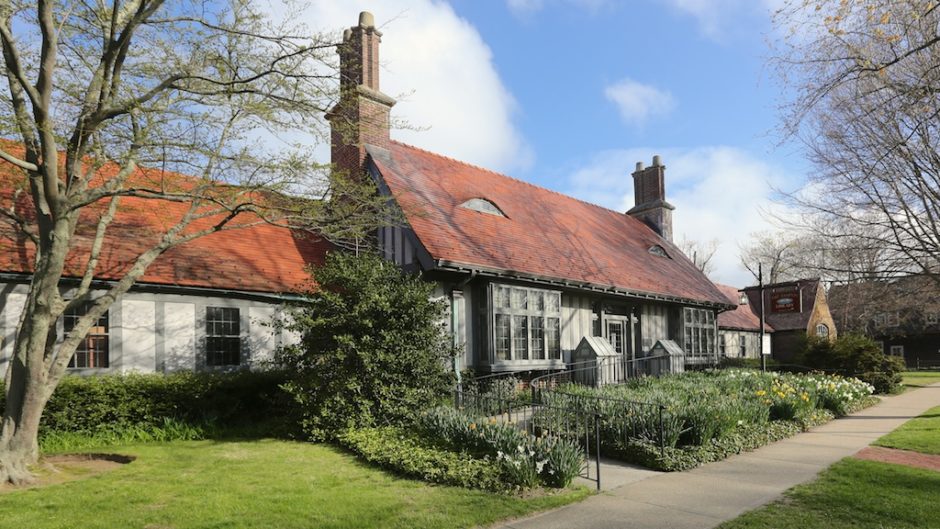
EAST HAMPTON LIBRARY, 1910 / 1911, 159 Main Street. In 1911, Mr. and Mrs. Lorenzo E. Woodhouse purchased the present site, and the Library building, the Woodhouses’ gift to the community, was begun. Three plans were submitted by architect Aymar Embury to the library board. It was this rural English Arts & Crafts style that was selected.
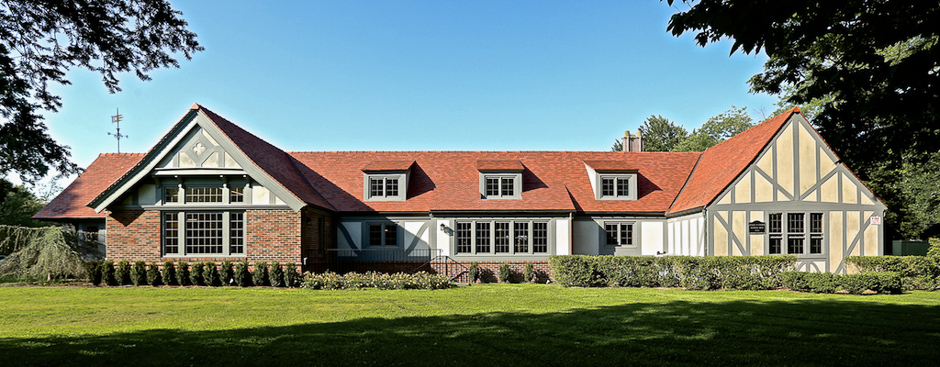
Children’s Wing added 2014.
Visit: easthamptonlibrary.org
————–
~~~~~~~~~~~~~ Miller-Papendieck-Poor House, 1911 ~~~~~~~~~~~~~

MILLER-PAPENDIECK-POOR HOUSE, 1911, 181 Main Street: While East Hampton’s summer colony developed along Ocean Avenue, some visitors created summer cottages on Main Street. The grandest of these is the J. Harper Poor House, an eighteenth century house remodeled by the architect Joseph Greenleaf Thorp into an Elizabethan cottage with stucco walls, rows of small-paned casement windows, half-tembering and carved wood brackets. Mr. Poor, a New York merchant, and Mr. Thorp were influenced by the Arts and Crafts movement which held a romantic view of medieval English architecture and its hand-crafted quality. The Village Green, with its strong connection to the English villages the settlers had left behind, seemed a perfect setting for this Elizabethan cottage.
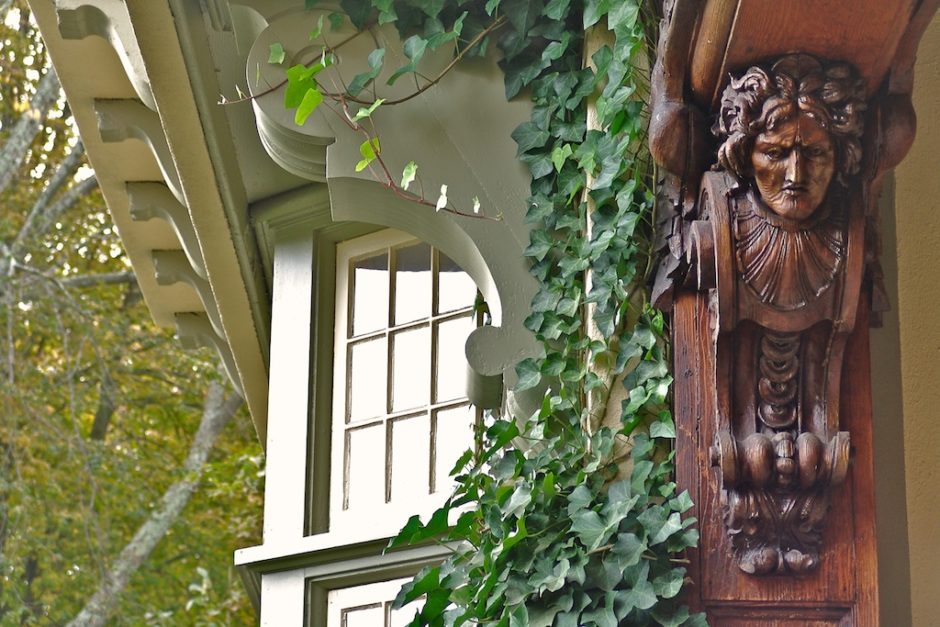
————–
~~~~~~~~~~~~~ Sixth East Hampton Post Office, 1917 ~~~~~~~~~~~~~
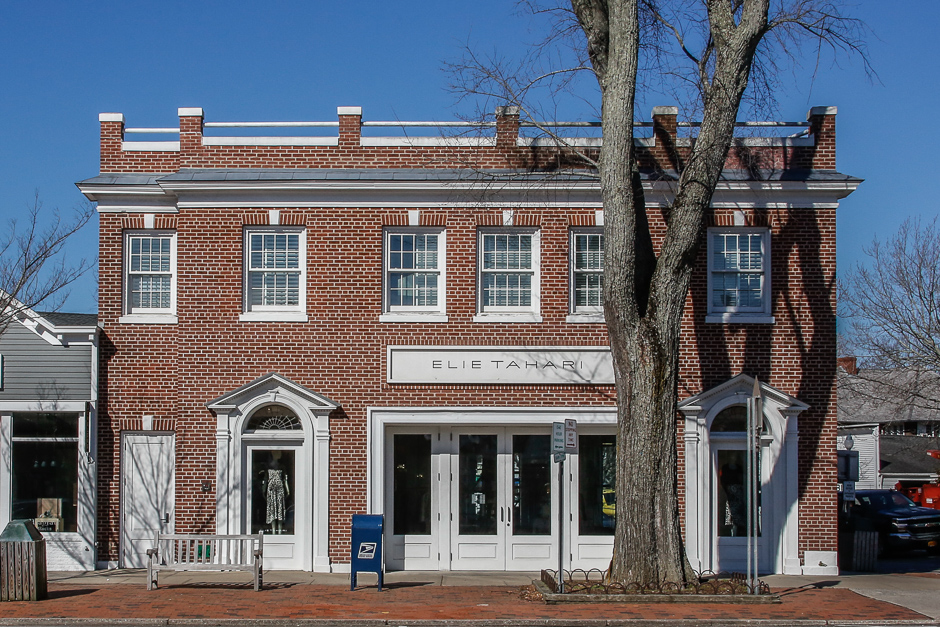
EAST HAMPTON POST OFFICE (6th), 1917, 1 Main Street. Two-story, brick, Colonial Revival style building. Flat roof; parapet-walled main facade with short brick piers and brick balustrade above projecting wood cornice. Second-level, double-hung, eight-over-eight windows with flat-arched, keystoned lintels. Former entrances at either end of main facade, now display windows, retain pilastered surrounds with pediments and stained-glass transoms. Central display windows with single entrance added.
————–
~~~~~~~~~~~~~ East Hampton National Bank 1918 ~~~~~~~~~~~~~
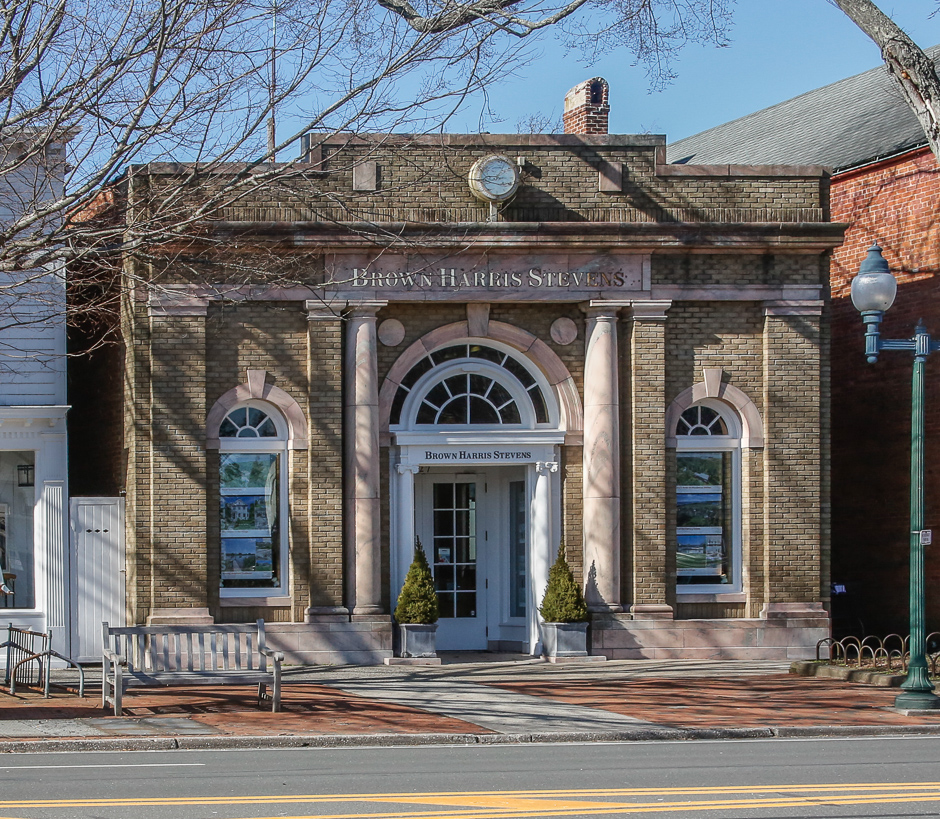
EAST HAMPTON NATIONAL BANK, 1918, 27 Main Street, East Hampton. One-story, Neoclassical style bank building with brick exterior and wood and marble trim. Flat roof with parapet-walled front. Brick pilasters and marble columns of the Doric order, all on marble bases, support a full entablature which incorporates a marble signboard. Center entrance is framed by wood colonnettes with Ionic capitals carrying an entablature surmounted by a large fanlight. Windows are set within marble keystoned round-arched openings.
————–
~~~~~~~~~~~~~ Maidstone Club, 1922 / 1924 ~~~~~~~~~~~~~

MAIDSTONE CLUBHOUSE, 1922 / 1924, 50 Old Beach Lane. Roger Bullard, architect.
The architect, Roger Bullard, chose a style that was as much inspired by French farmhouses as it was by the English vernacular cottages. Bullard wrote, “The skyline of the building conforms to the undulation of the dunes, the wings at either end rising gradually to the main ridge, the general character and roofline suggesting the farm houses of Normandy.”
Archival Postcard / Ginsburg Postcard Collection. Courtesy of East Hampton Library.
————–
~~~~~~~~~~~~~ Village Green Flag Pole, 1926 ~~~~~~~~~~~~~
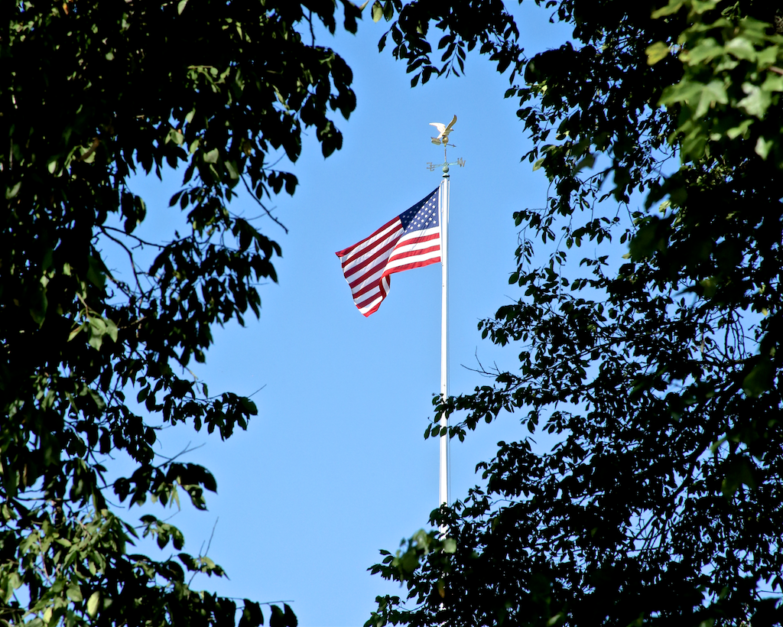
“This Flag Pole dedicated to the Village of East Hampton in memory of George Lodowick McAlpin, 1856-1922, by members of his family, July 4, 1926.” — Plaque.
————–
~~~~~~~~~~~~~ Guild Hall, 1931 ~~~~~~~~~~~~~

GUILD HALL, 1931, 158 Main Street: This striking Georgian Revival building, designed by architect Aymar Embury, was opened in 1931 as a combination art gallery and performing arts space.
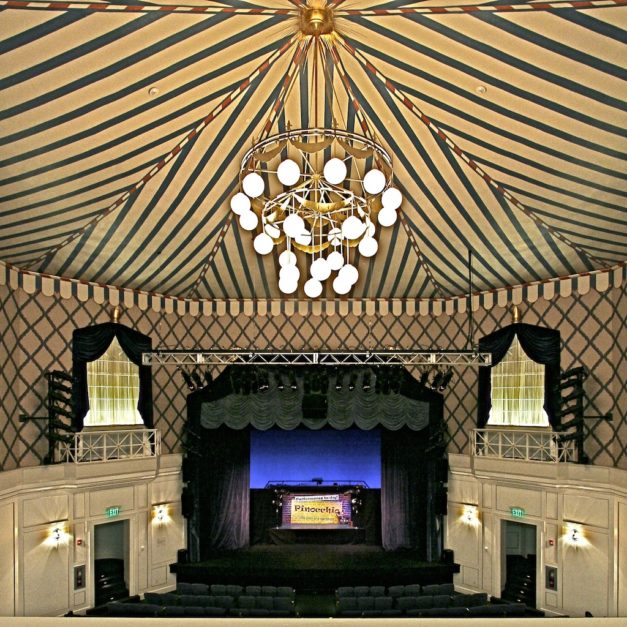
————–
~~~~~~~~~~~~~ Nature Trail, 1951 ~~~~~~~~~~~~~
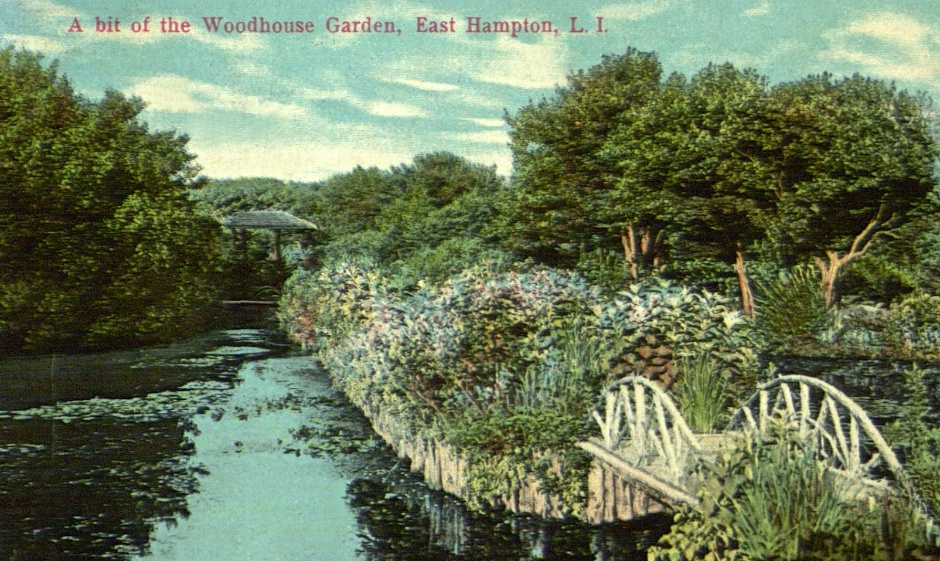
EAST HAMPTON NATURE TRAIL, 1951: David’s Lane. In 1951, Mrs. Mary Woodhouse donated eight acres of her Japanese garden to the Village of East Hampton. Sixteen acres have been added since. The Nature Trail offers paths, benches & bridges year round. LVIS and the Garden Club of East Hampton maintain the trails.
Archival Postcard / Ginsburg Postcard Collection. Courtesy of East Hampton Library.
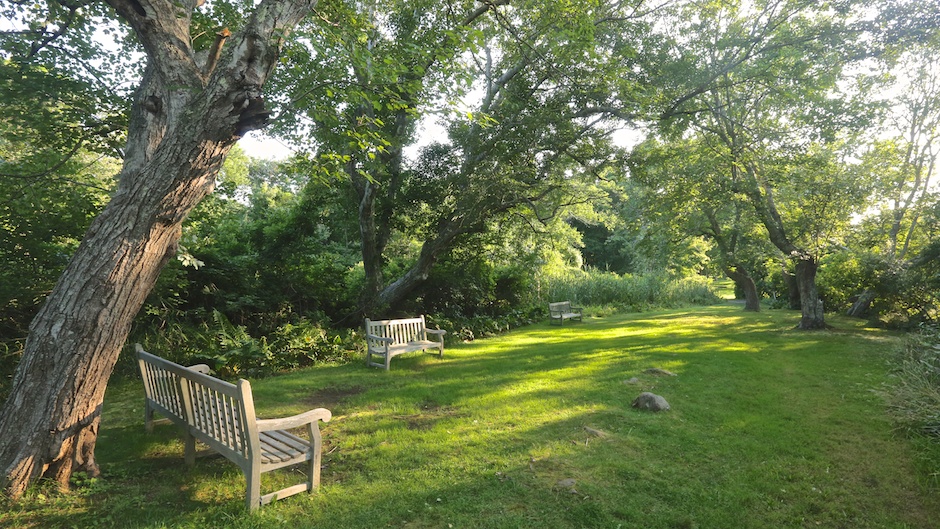
————–
~~~~~~~~~~~~~ Gates of the Grove Synagogue, 1988 ~~~~~~~~~~~~~

GATES OF THE GROVE SYNAGOGUE, 1988. Norman Jaffe, architect.
Taking its basic architectural theme from the chuppa or portico, this synagogue is a replacement for an existing wood frame building. The new space will be connected to an existing Memorial Grove of trees. The entry way is low in scale and tight in width, designed to help worshippers to shed their daily concerns and prepare for prayer. The stone floors are laid in an irregular pattern with minimal joints recalling limestone blocks of Jerusalem Walls. The portico theme begins at the entry and repeats in a series of interlocking, ascending proticos that come to full height at center and then descend to a thrust bimah. The ark is the last portical; a building in itself. The angular columns, recalling the character of Hebrew script, bend upwards. The repetition of forms suggests a tradition of Jewish worship, a steadfastness of dovening.
The number ten is significant in Hebrew tradition–ten commandments, ten men make a minion, ten tribes, etc. The sanctuary is enclosed by ten sections, each formed of two columns infill above and a niche for seating. The sections become roofs at their intersection with the horizontal plane, each separated by light. The sections are named each after one of the ten branches of the sephirot, a tree-life form common to Hebrew iconography. The sephirot motif reappears in the hand rails, column capitals, exterior window frames and inside the ark itself. The building is genearlly lit by ambient or north light with the exception of the ark upon which east and west light is allowed to wash, highlighting this surface from others.
— Project Description
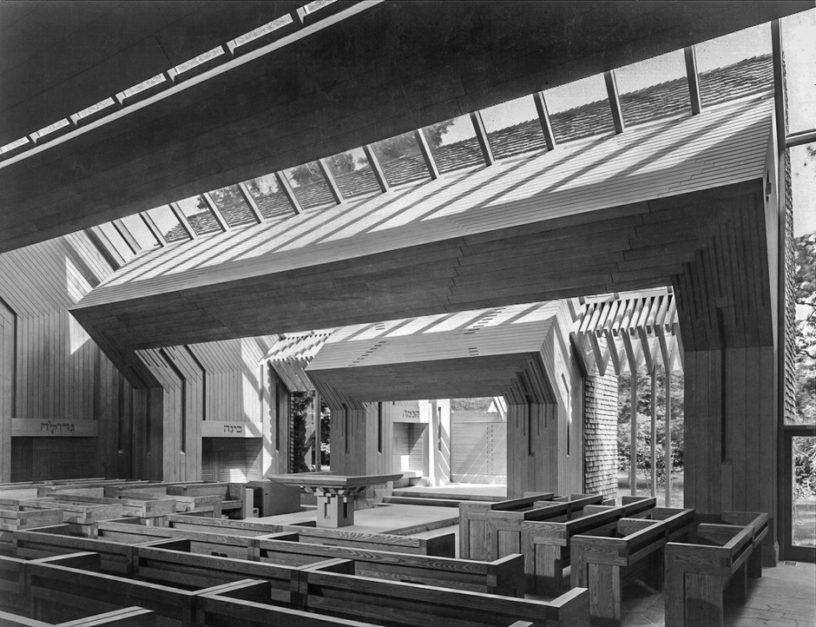
————–
~~~~~~~~~~~~~ Village Green & Town Pond ~~~~~~~~~~~~~
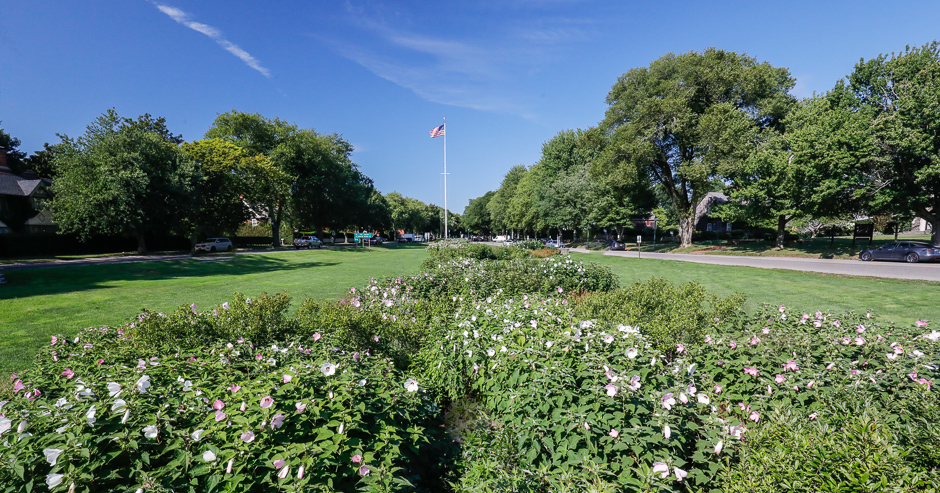
Village Green, 2019
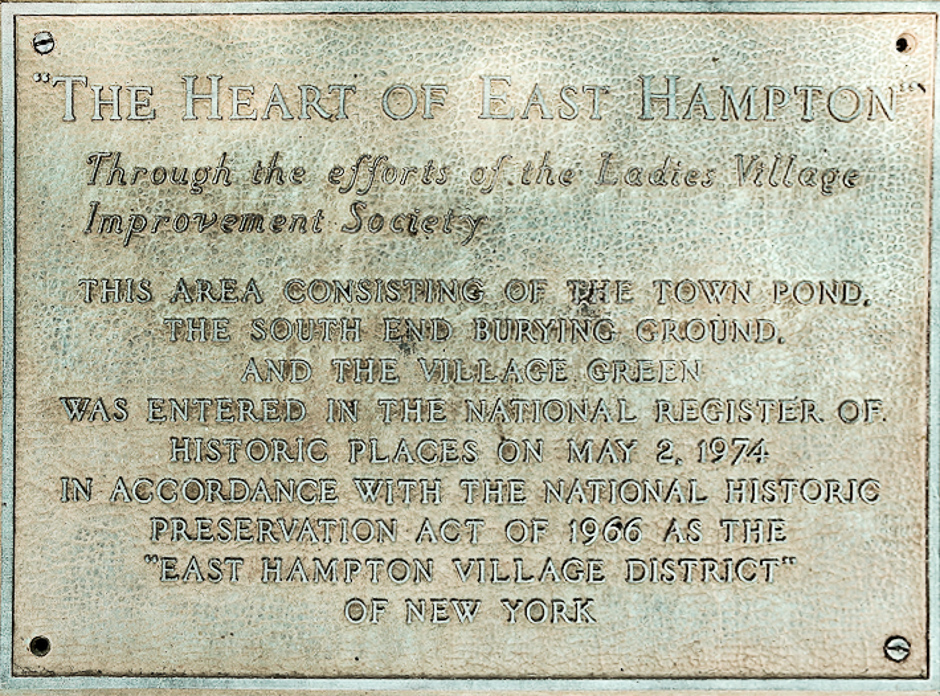
“THE HEART OF EAST HAMPTON”
Through the efforts of the Ladies Village Improvement Society
This area consisting of the Town Pond,
The South End Burying Ground,
And the Village Green
Was entered in the National Register of Historic Places
On May 2, 1974
In accordance with the National Historic
Preservation Act of 1966 as the
“EAST HAMPTON VILLAGE DISTRICT”
of New York

Town Pond
——————————————-
Visit following AAQ Portfolios:
TOURS
East Hampton Main Street Historic District / East.
East Hampton Main Street Historic District / West.
East Hampton: Ocean Avenue to Main Beach Tour
Huntting Lane & Nature Trail, East Hampton
LANDMARKS
Clinton Academy, 1784, East Hampton
Gardiner Mill, 1804, East Hampton
Home Sweet Home, c. 1720, East Hampton
Hook Mill, East Hampton, 1736 / 1806
Mulford Farm, ca. 1680. East Hampton
Osborn-Jackson House, c. 1720, East Hampton
Pantigo Mill, 1804, East Hampton
HISTORIC STRUCTURES
Home, Sweet Home, c. 1720, East Hampton / Hefner w/ King.
Moran Studio, East Hampton / Hefner w/ Barons, 2009.
RESTORATIONS
Dominy House, c. 1770, East Hampton
Gardiner Mill Cottage Gallery, East Hampton
Isaac Osborne House, East Hampton
Moran Studio, 1884: The Art of Restoration
RELATED
East Hampton Village Train Station / Restored to 1895 Appearance.
Norman Jaffe, Gates of the Grove, East Hampton, 1988.
——————–
Text by Robert Hefner, Director of Historic Services, Village of East Hampton; and Richard Barons, Executive Director, East Hampton Historical Society.
Reference: East Hampton’s Heritage — An Illustrated Architectural Record — Lancaster, Stern, Hefner — Published by Ladies Village Improvement Society, 1982.
Photographs & content selected & edited by Jeff Heatley.
Photographs, except postcard views, © Jeff Heatley.
——————————

EXCLUSIVE PORTFOLIO
________________________________________________________________________
